Enterprises Storage Environment | Report 1
VerifiedAdded on 2022/10/02
|17
|5215
|17
AI Summary
Contribute Materials
Your contribution can guide someone’s learning journey. Share your
documents today.
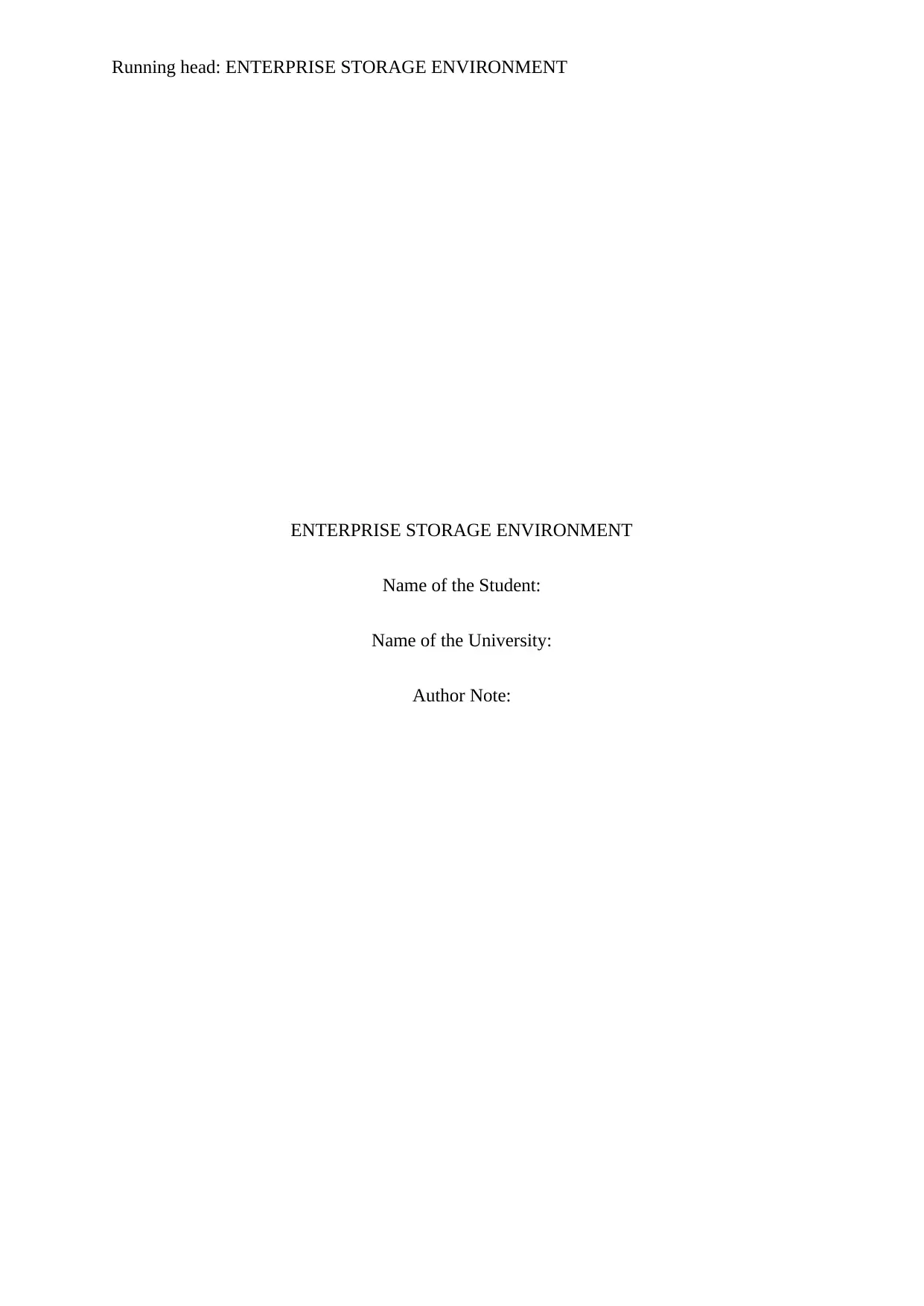
Running head: ENTERPRISE STORAGE ENVIRONMENT
ENTERPRISE STORAGE ENVIRONMENT
Name of the Student:
Name of the University:
Author Note:
ENTERPRISE STORAGE ENVIRONMENT
Name of the Student:
Name of the University:
Author Note:
Secure Best Marks with AI Grader
Need help grading? Try our AI Grader for instant feedback on your assignments.
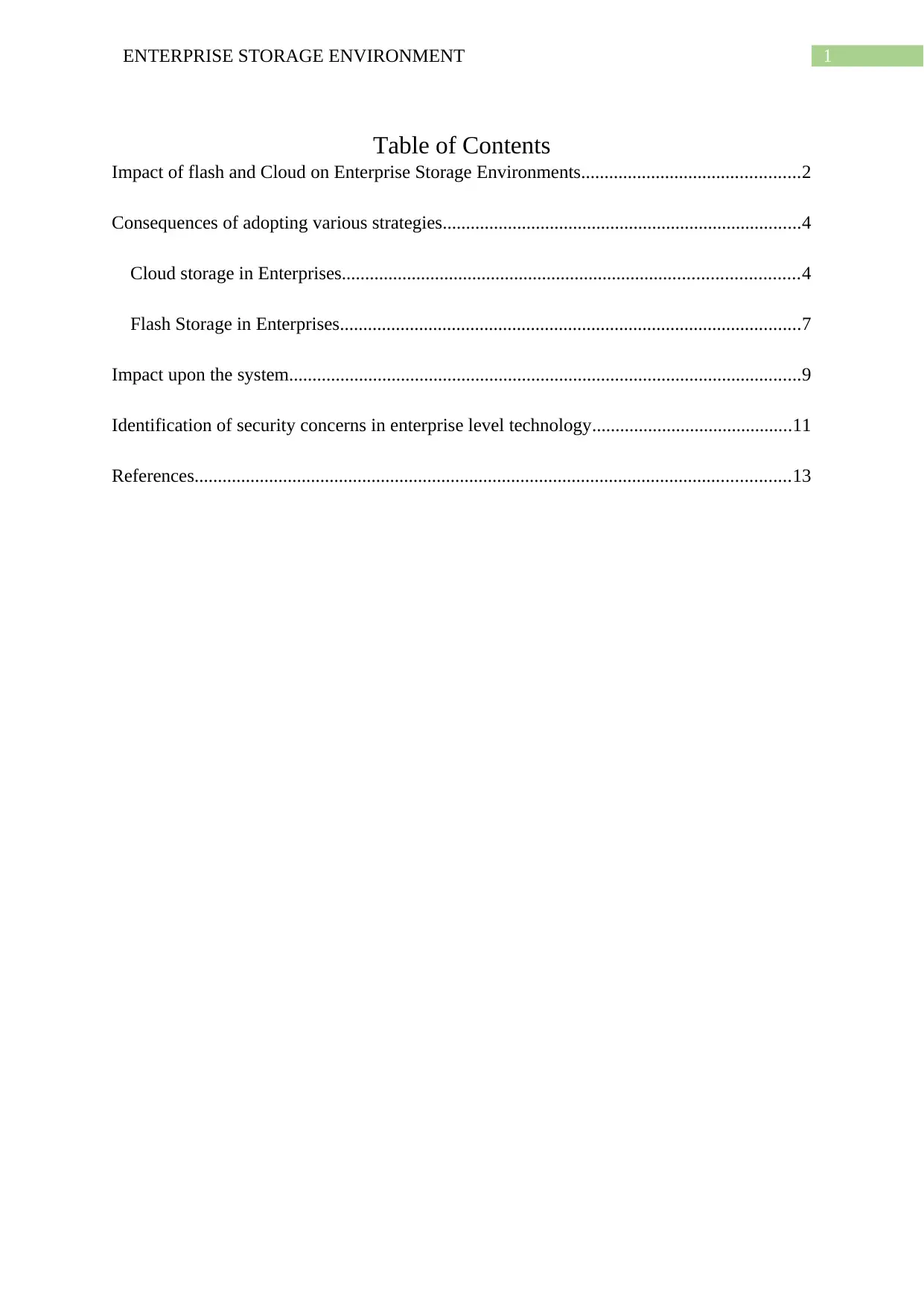
1ENTERPRISE STORAGE ENVIRONMENT
Table of Contents
Impact of flash and Cloud on Enterprise Storage Environments...............................................2
Consequences of adopting various strategies.............................................................................4
Cloud storage in Enterprises..................................................................................................4
Flash Storage in Enterprises...................................................................................................7
Impact upon the system..............................................................................................................9
Identification of security concerns in enterprise level technology...........................................11
References................................................................................................................................13
Table of Contents
Impact of flash and Cloud on Enterprise Storage Environments...............................................2
Consequences of adopting various strategies.............................................................................4
Cloud storage in Enterprises..................................................................................................4
Flash Storage in Enterprises...................................................................................................7
Impact upon the system..............................................................................................................9
Identification of security concerns in enterprise level technology...........................................11
References................................................................................................................................13
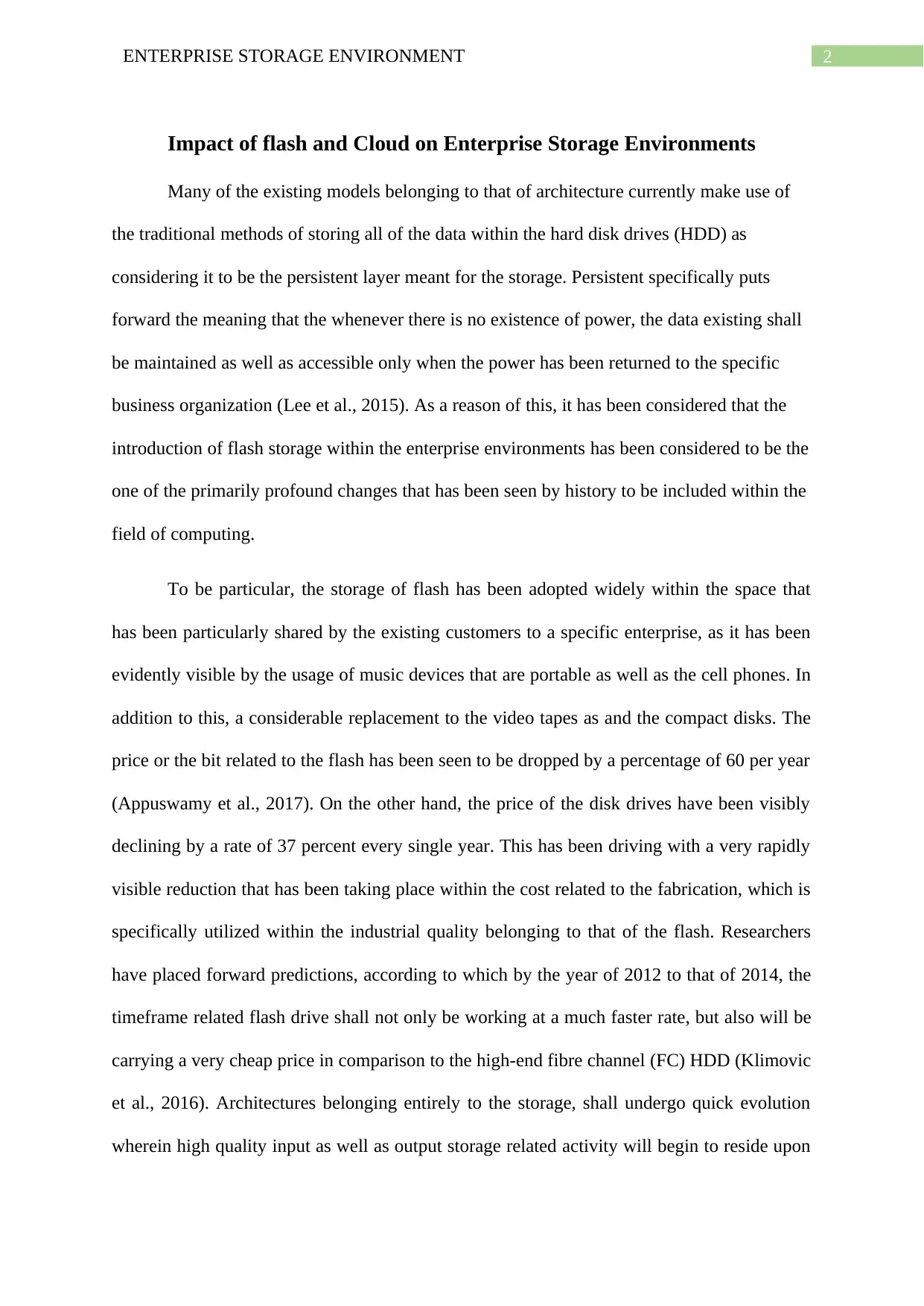
2ENTERPRISE STORAGE ENVIRONMENT
Impact of flash and Cloud on Enterprise Storage Environments
Many of the existing models belonging to that of architecture currently make use of
the traditional methods of storing all of the data within the hard disk drives (HDD) as
considering it to be the persistent layer meant for the storage. Persistent specifically puts
forward the meaning that the whenever there is no existence of power, the data existing shall
be maintained as well as accessible only when the power has been returned to the specific
business organization (Lee et al., 2015). As a reason of this, it has been considered that the
introduction of flash storage within the enterprise environments has been considered to be the
one of the primarily profound changes that has been seen by history to be included within the
field of computing.
To be particular, the storage of flash has been adopted widely within the space that
has been particularly shared by the existing customers to a specific enterprise, as it has been
evidently visible by the usage of music devices that are portable as well as the cell phones. In
addition to this, a considerable replacement to the video tapes as and the compact disks. The
price or the bit related to the flash has been seen to be dropped by a percentage of 60 per year
(Appuswamy et al., 2017). On the other hand, the price of the disk drives have been visibly
declining by a rate of 37 percent every single year. This has been driving with a very rapidly
visible reduction that has been taking place within the cost related to the fabrication, which is
specifically utilized within the industrial quality belonging to that of the flash. Researchers
have placed forward predictions, according to which by the year of 2012 to that of 2014, the
timeframe related flash drive shall not only be working at a much faster rate, but also will be
carrying a very cheap price in comparison to the high-end fibre channel (FC) HDD (Klimovic
et al., 2016). Architectures belonging entirely to the storage, shall undergo quick evolution
wherein high quality input as well as output storage related activity will begin to reside upon
Impact of flash and Cloud on Enterprise Storage Environments
Many of the existing models belonging to that of architecture currently make use of
the traditional methods of storing all of the data within the hard disk drives (HDD) as
considering it to be the persistent layer meant for the storage. Persistent specifically puts
forward the meaning that the whenever there is no existence of power, the data existing shall
be maintained as well as accessible only when the power has been returned to the specific
business organization (Lee et al., 2015). As a reason of this, it has been considered that the
introduction of flash storage within the enterprise environments has been considered to be the
one of the primarily profound changes that has been seen by history to be included within the
field of computing.
To be particular, the storage of flash has been adopted widely within the space that
has been particularly shared by the existing customers to a specific enterprise, as it has been
evidently visible by the usage of music devices that are portable as well as the cell phones. In
addition to this, a considerable replacement to the video tapes as and the compact disks. The
price or the bit related to the flash has been seen to be dropped by a percentage of 60 per year
(Appuswamy et al., 2017). On the other hand, the price of the disk drives have been visibly
declining by a rate of 37 percent every single year. This has been driving with a very rapidly
visible reduction that has been taking place within the cost related to the fabrication, which is
specifically utilized within the industrial quality belonging to that of the flash. Researchers
have placed forward predictions, according to which by the year of 2012 to that of 2014, the
timeframe related flash drive shall not only be working at a much faster rate, but also will be
carrying a very cheap price in comparison to the high-end fibre channel (FC) HDD (Klimovic
et al., 2016). Architectures belonging entirely to the storage, shall undergo quick evolution
wherein high quality input as well as output storage related activity will begin to reside upon
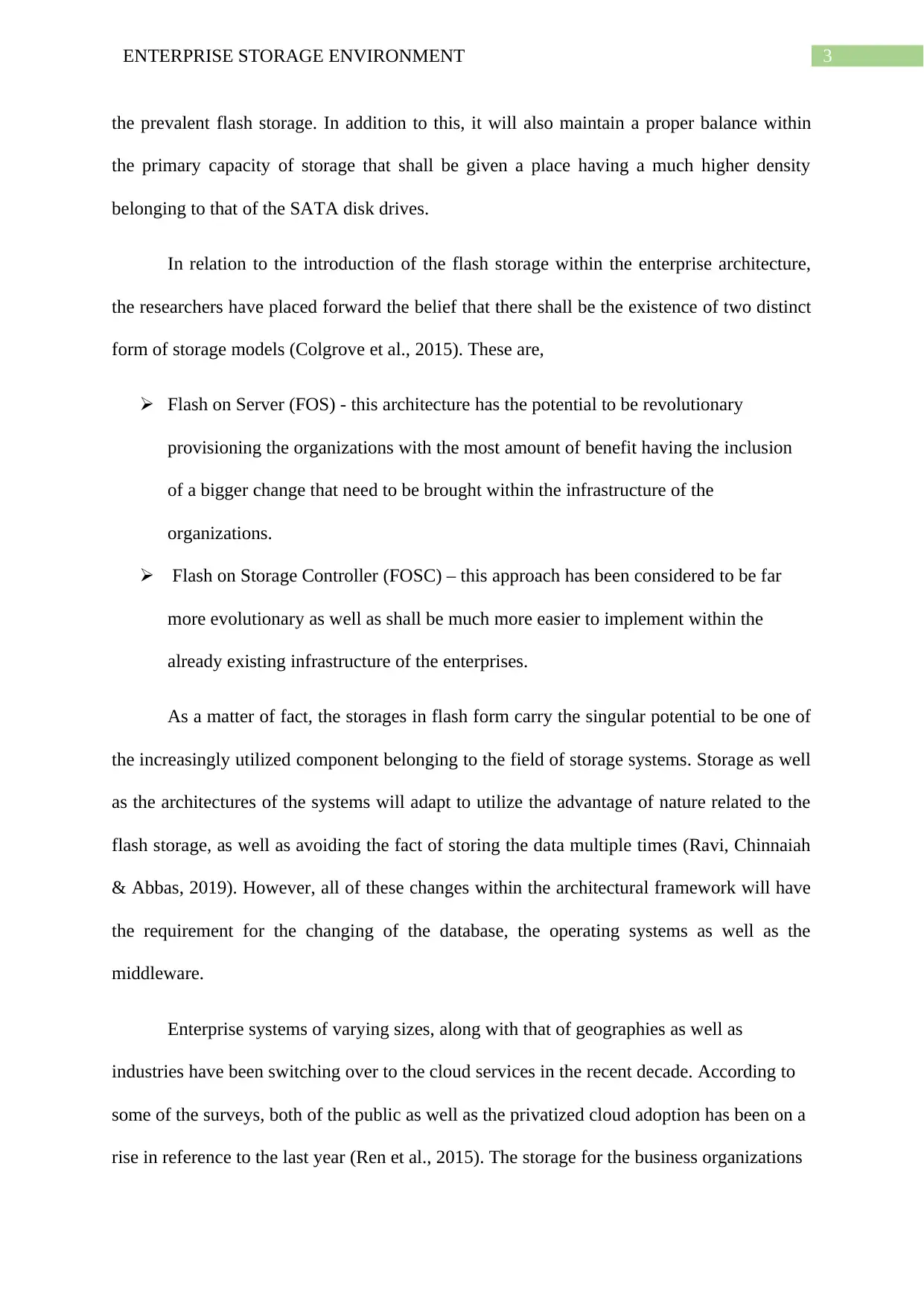
3ENTERPRISE STORAGE ENVIRONMENT
the prevalent flash storage. In addition to this, it will also maintain a proper balance within
the primary capacity of storage that shall be given a place having a much higher density
belonging to that of the SATA disk drives.
In relation to the introduction of the flash storage within the enterprise architecture,
the researchers have placed forward the belief that there shall be the existence of two distinct
form of storage models (Colgrove et al., 2015). These are,
Flash on Server (FOS) - this architecture has the potential to be revolutionary
provisioning the organizations with the most amount of benefit having the inclusion
of a bigger change that need to be brought within the infrastructure of the
organizations.
Flash on Storage Controller (FOSC) – this approach has been considered to be far
more evolutionary as well as shall be much more easier to implement within the
already existing infrastructure of the enterprises.
As a matter of fact, the storages in flash form carry the singular potential to be one of
the increasingly utilized component belonging to the field of storage systems. Storage as well
as the architectures of the systems will adapt to utilize the advantage of nature related to the
flash storage, as well as avoiding the fact of storing the data multiple times (Ravi, Chinnaiah
& Abbas, 2019). However, all of these changes within the architectural framework will have
the requirement for the changing of the database, the operating systems as well as the
middleware.
Enterprise systems of varying sizes, along with that of geographies as well as
industries have been switching over to the cloud services in the recent decade. According to
some of the surveys, both of the public as well as the privatized cloud adoption has been on a
rise in reference to the last year (Ren et al., 2015). The storage for the business organizations
the prevalent flash storage. In addition to this, it will also maintain a proper balance within
the primary capacity of storage that shall be given a place having a much higher density
belonging to that of the SATA disk drives.
In relation to the introduction of the flash storage within the enterprise architecture,
the researchers have placed forward the belief that there shall be the existence of two distinct
form of storage models (Colgrove et al., 2015). These are,
Flash on Server (FOS) - this architecture has the potential to be revolutionary
provisioning the organizations with the most amount of benefit having the inclusion
of a bigger change that need to be brought within the infrastructure of the
organizations.
Flash on Storage Controller (FOSC) – this approach has been considered to be far
more evolutionary as well as shall be much more easier to implement within the
already existing infrastructure of the enterprises.
As a matter of fact, the storages in flash form carry the singular potential to be one of
the increasingly utilized component belonging to the field of storage systems. Storage as well
as the architectures of the systems will adapt to utilize the advantage of nature related to the
flash storage, as well as avoiding the fact of storing the data multiple times (Ravi, Chinnaiah
& Abbas, 2019). However, all of these changes within the architectural framework will have
the requirement for the changing of the database, the operating systems as well as the
middleware.
Enterprise systems of varying sizes, along with that of geographies as well as
industries have been switching over to the cloud services in the recent decade. According to
some of the surveys, both of the public as well as the privatized cloud adoption has been on a
rise in reference to the last year (Ren et al., 2015). The storage for the business organizations
Secure Best Marks with AI Grader
Need help grading? Try our AI Grader for instant feedback on your assignments.
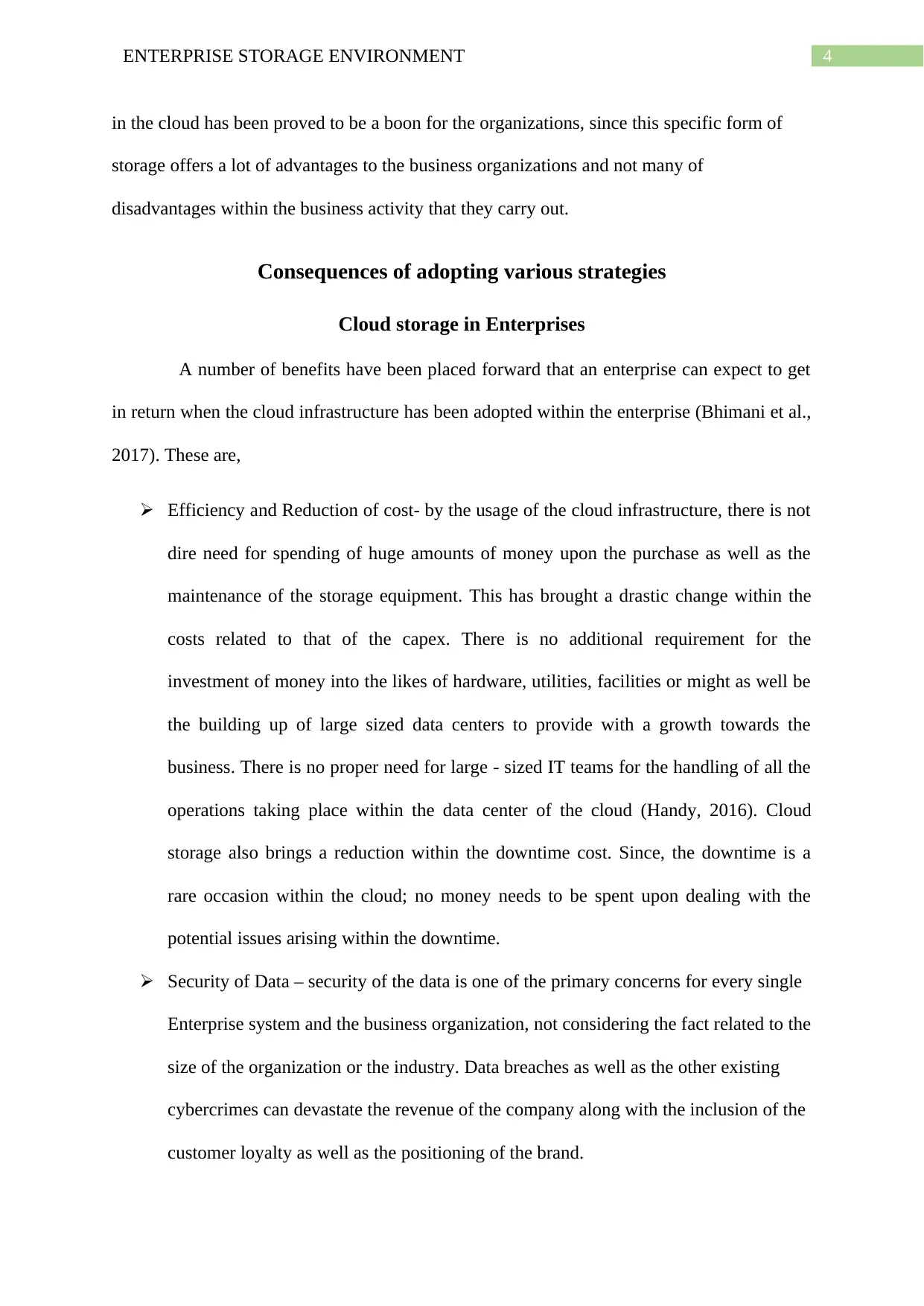
4ENTERPRISE STORAGE ENVIRONMENT
in the cloud has been proved to be a boon for the organizations, since this specific form of
storage offers a lot of advantages to the business organizations and not many of
disadvantages within the business activity that they carry out.
Consequences of adopting various strategies
Cloud storage in Enterprises
A number of benefits have been placed forward that an enterprise can expect to get
in return when the cloud infrastructure has been adopted within the enterprise (Bhimani et al.,
2017). These are,
Efficiency and Reduction of cost- by the usage of the cloud infrastructure, there is not
dire need for spending of huge amounts of money upon the purchase as well as the
maintenance of the storage equipment. This has brought a drastic change within the
costs related to that of the capex. There is no additional requirement for the
investment of money into the likes of hardware, utilities, facilities or might as well be
the building up of large sized data centers to provide with a growth towards the
business. There is no proper need for large - sized IT teams for the handling of all the
operations taking place within the data center of the cloud (Handy, 2016). Cloud
storage also brings a reduction within the downtime cost. Since, the downtime is a
rare occasion within the cloud; no money needs to be spent upon dealing with the
potential issues arising within the downtime.
Security of Data – security of the data is one of the primary concerns for every single
Enterprise system and the business organization, not considering the fact related to the
size of the organization or the industry. Data breaches as well as the other existing
cybercrimes can devastate the revenue of the company along with the inclusion of the
customer loyalty as well as the positioning of the brand.
in the cloud has been proved to be a boon for the organizations, since this specific form of
storage offers a lot of advantages to the business organizations and not many of
disadvantages within the business activity that they carry out.
Consequences of adopting various strategies
Cloud storage in Enterprises
A number of benefits have been placed forward that an enterprise can expect to get
in return when the cloud infrastructure has been adopted within the enterprise (Bhimani et al.,
2017). These are,
Efficiency and Reduction of cost- by the usage of the cloud infrastructure, there is not
dire need for spending of huge amounts of money upon the purchase as well as the
maintenance of the storage equipment. This has brought a drastic change within the
costs related to that of the capex. There is no additional requirement for the
investment of money into the likes of hardware, utilities, facilities or might as well be
the building up of large sized data centers to provide with a growth towards the
business. There is no proper need for large - sized IT teams for the handling of all the
operations taking place within the data center of the cloud (Handy, 2016). Cloud
storage also brings a reduction within the downtime cost. Since, the downtime is a
rare occasion within the cloud; no money needs to be spent upon dealing with the
potential issues arising within the downtime.
Security of Data – security of the data is one of the primary concerns for every single
Enterprise system and the business organization, not considering the fact related to the
size of the organization or the industry. Data breaches as well as the other existing
cybercrimes can devastate the revenue of the company along with the inclusion of the
customer loyalty as well as the positioning of the brand.
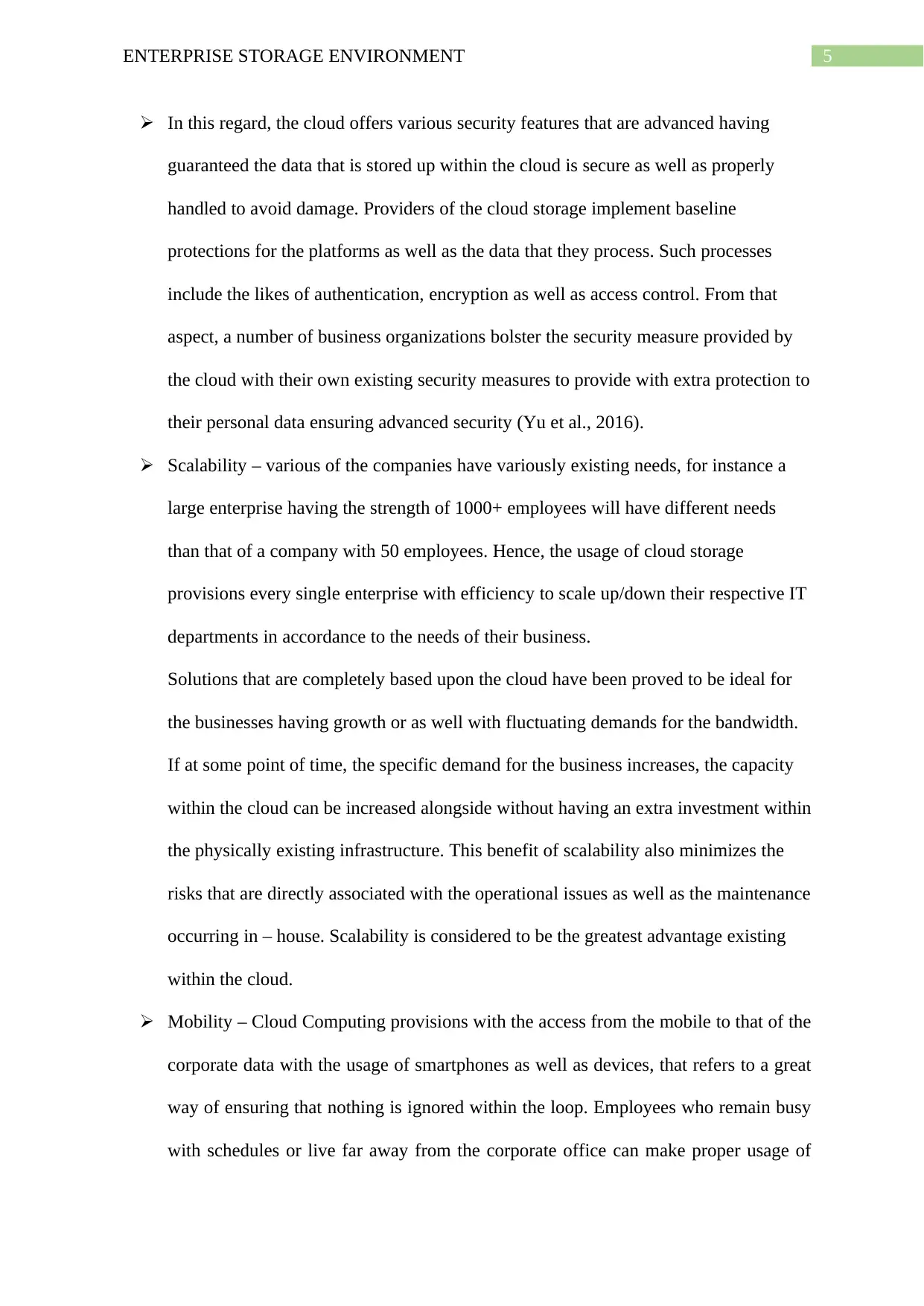
5ENTERPRISE STORAGE ENVIRONMENT
In this regard, the cloud offers various security features that are advanced having
guaranteed the data that is stored up within the cloud is secure as well as properly
handled to avoid damage. Providers of the cloud storage implement baseline
protections for the platforms as well as the data that they process. Such processes
include the likes of authentication, encryption as well as access control. From that
aspect, a number of business organizations bolster the security measure provided by
the cloud with their own existing security measures to provide with extra protection to
their personal data ensuring advanced security (Yu et al., 2016).
Scalability – various of the companies have variously existing needs, for instance a
large enterprise having the strength of 1000+ employees will have different needs
than that of a company with 50 employees. Hence, the usage of cloud storage
provisions every single enterprise with efficiency to scale up/down their respective IT
departments in accordance to the needs of their business.
Solutions that are completely based upon the cloud have been proved to be ideal for
the businesses having growth or as well with fluctuating demands for the bandwidth.
If at some point of time, the specific demand for the business increases, the capacity
within the cloud can be increased alongside without having an extra investment within
the physically existing infrastructure. This benefit of scalability also minimizes the
risks that are directly associated with the operational issues as well as the maintenance
occurring in – house. Scalability is considered to be the greatest advantage existing
within the cloud.
Mobility – Cloud Computing provisions with the access from the mobile to that of the
corporate data with the usage of smartphones as well as devices, that refers to a great
way of ensuring that nothing is ignored within the loop. Employees who remain busy
with schedules or live far away from the corporate office can make proper usage of
In this regard, the cloud offers various security features that are advanced having
guaranteed the data that is stored up within the cloud is secure as well as properly
handled to avoid damage. Providers of the cloud storage implement baseline
protections for the platforms as well as the data that they process. Such processes
include the likes of authentication, encryption as well as access control. From that
aspect, a number of business organizations bolster the security measure provided by
the cloud with their own existing security measures to provide with extra protection to
their personal data ensuring advanced security (Yu et al., 2016).
Scalability – various of the companies have variously existing needs, for instance a
large enterprise having the strength of 1000+ employees will have different needs
than that of a company with 50 employees. Hence, the usage of cloud storage
provisions every single enterprise with efficiency to scale up/down their respective IT
departments in accordance to the needs of their business.
Solutions that are completely based upon the cloud have been proved to be ideal for
the businesses having growth or as well with fluctuating demands for the bandwidth.
If at some point of time, the specific demand for the business increases, the capacity
within the cloud can be increased alongside without having an extra investment within
the physically existing infrastructure. This benefit of scalability also minimizes the
risks that are directly associated with the operational issues as well as the maintenance
occurring in – house. Scalability is considered to be the greatest advantage existing
within the cloud.
Mobility – Cloud Computing provisions with the access from the mobile to that of the
corporate data with the usage of smartphones as well as devices, that refers to a great
way of ensuring that nothing is ignored within the loop. Employees who remain busy
with schedules or live far away from the corporate office can make proper usage of
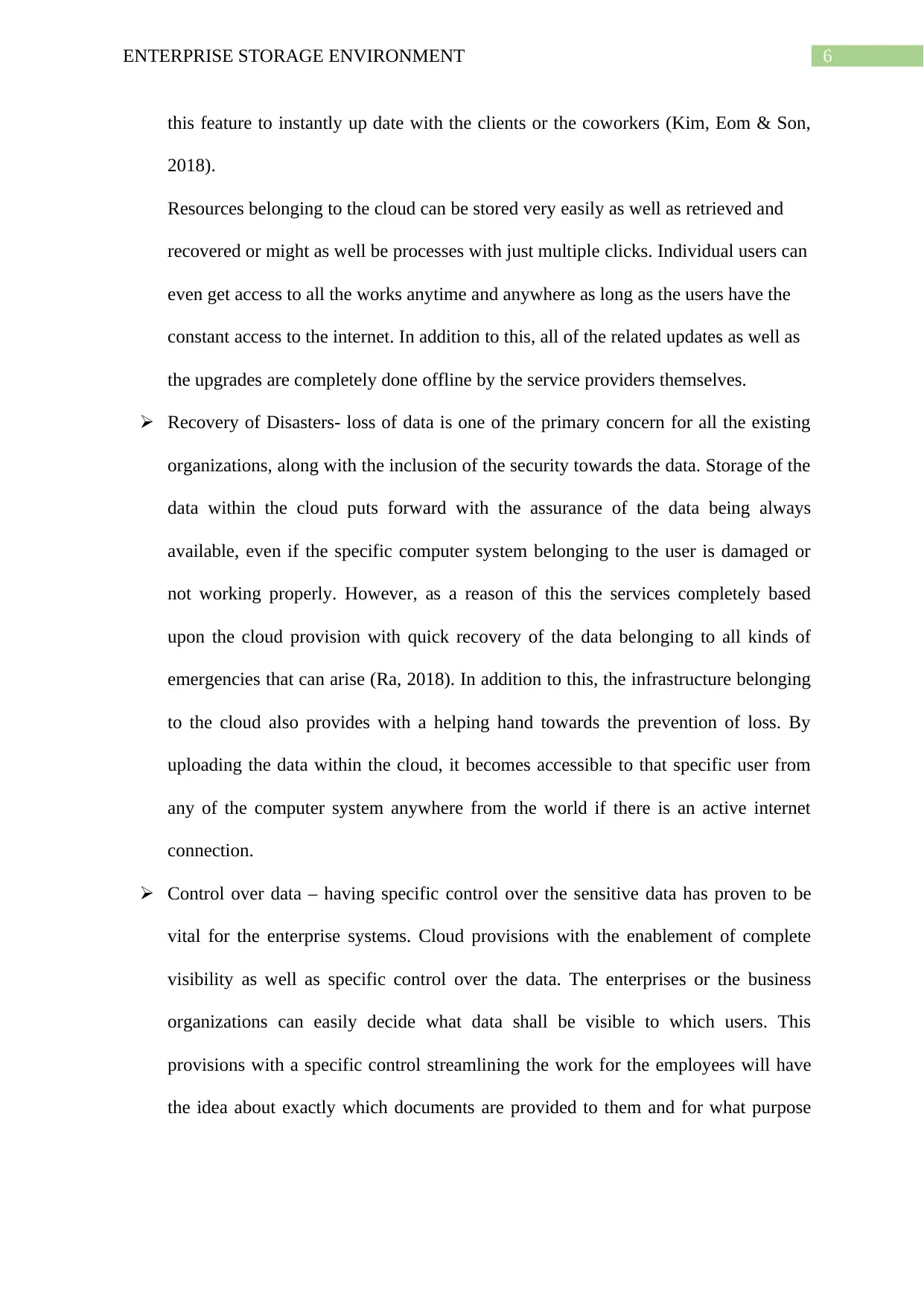
6ENTERPRISE STORAGE ENVIRONMENT
this feature to instantly up date with the clients or the coworkers (Kim, Eom & Son,
2018).
Resources belonging to the cloud can be stored very easily as well as retrieved and
recovered or might as well be processes with just multiple clicks. Individual users can
even get access to all the works anytime and anywhere as long as the users have the
constant access to the internet. In addition to this, all of the related updates as well as
the upgrades are completely done offline by the service providers themselves.
Recovery of Disasters- loss of data is one of the primary concern for all the existing
organizations, along with the inclusion of the security towards the data. Storage of the
data within the cloud puts forward with the assurance of the data being always
available, even if the specific computer system belonging to the user is damaged or
not working properly. However, as a reason of this the services completely based
upon the cloud provision with quick recovery of the data belonging to all kinds of
emergencies that can arise (Ra, 2018). In addition to this, the infrastructure belonging
to the cloud also provides with a helping hand towards the prevention of loss. By
uploading the data within the cloud, it becomes accessible to that specific user from
any of the computer system anywhere from the world if there is an active internet
connection.
Control over data – having specific control over the sensitive data has proven to be
vital for the enterprise systems. Cloud provisions with the enablement of complete
visibility as well as specific control over the data. The enterprises or the business
organizations can easily decide what data shall be visible to which users. This
provisions with a specific control streamlining the work for the employees will have
the idea about exactly which documents are provided to them and for what purpose
this feature to instantly up date with the clients or the coworkers (Kim, Eom & Son,
2018).
Resources belonging to the cloud can be stored very easily as well as retrieved and
recovered or might as well be processes with just multiple clicks. Individual users can
even get access to all the works anytime and anywhere as long as the users have the
constant access to the internet. In addition to this, all of the related updates as well as
the upgrades are completely done offline by the service providers themselves.
Recovery of Disasters- loss of data is one of the primary concern for all the existing
organizations, along with the inclusion of the security towards the data. Storage of the
data within the cloud puts forward with the assurance of the data being always
available, even if the specific computer system belonging to the user is damaged or
not working properly. However, as a reason of this the services completely based
upon the cloud provision with quick recovery of the data belonging to all kinds of
emergencies that can arise (Ra, 2018). In addition to this, the infrastructure belonging
to the cloud also provides with a helping hand towards the prevention of loss. By
uploading the data within the cloud, it becomes accessible to that specific user from
any of the computer system anywhere from the world if there is an active internet
connection.
Control over data – having specific control over the sensitive data has proven to be
vital for the enterprise systems. Cloud provisions with the enablement of complete
visibility as well as specific control over the data. The enterprises or the business
organizations can easily decide what data shall be visible to which users. This
provisions with a specific control streamlining the work for the employees will have
the idea about exactly which documents are provided to them and for what purpose
Paraphrase This Document
Need a fresh take? Get an instant paraphrase of this document with our AI Paraphraser
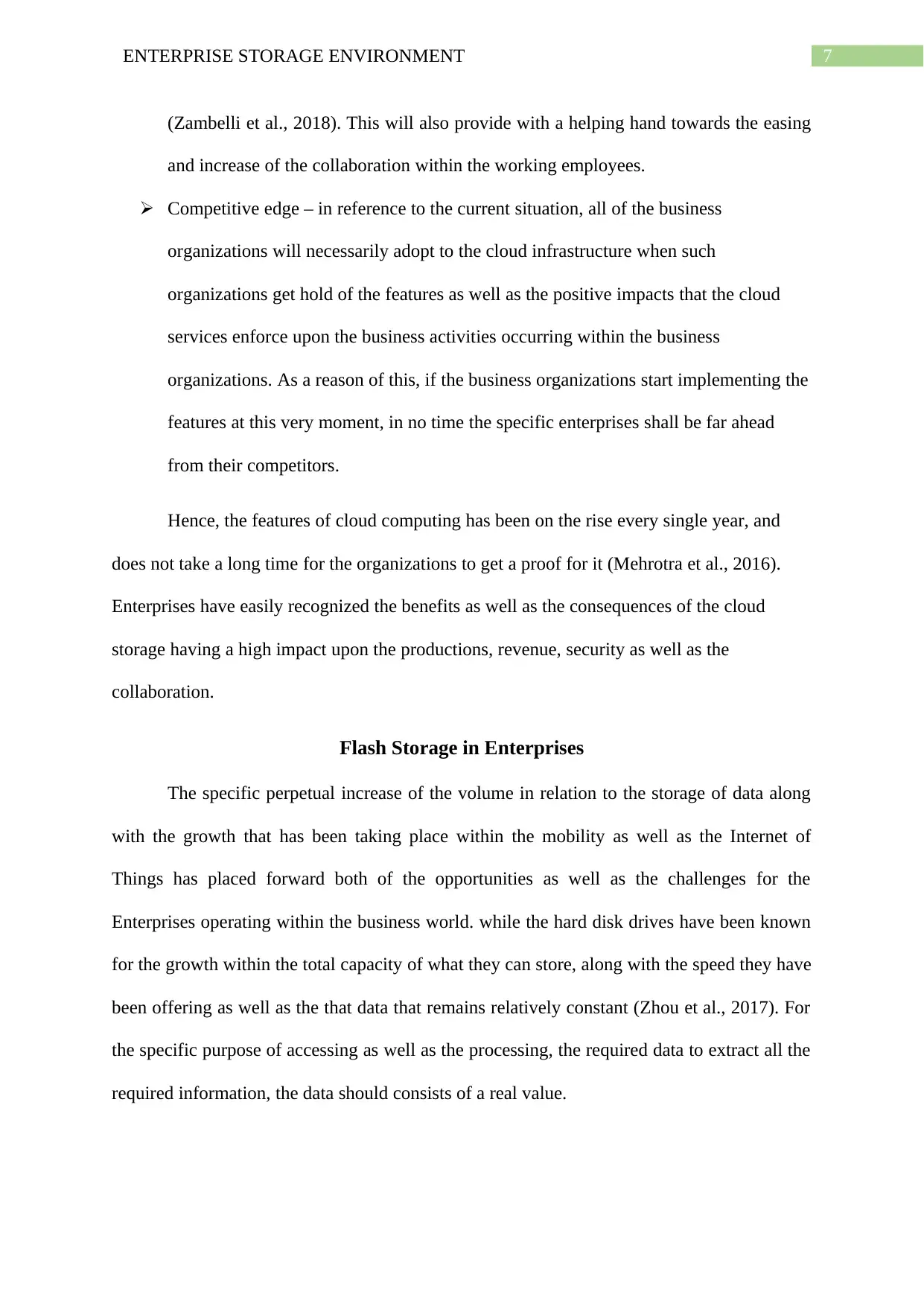
7ENTERPRISE STORAGE ENVIRONMENT
(Zambelli et al., 2018). This will also provide with a helping hand towards the easing
and increase of the collaboration within the working employees.
Competitive edge – in reference to the current situation, all of the business
organizations will necessarily adopt to the cloud infrastructure when such
organizations get hold of the features as well as the positive impacts that the cloud
services enforce upon the business activities occurring within the business
organizations. As a reason of this, if the business organizations start implementing the
features at this very moment, in no time the specific enterprises shall be far ahead
from their competitors.
Hence, the features of cloud computing has been on the rise every single year, and
does not take a long time for the organizations to get a proof for it (Mehrotra et al., 2016).
Enterprises have easily recognized the benefits as well as the consequences of the cloud
storage having a high impact upon the productions, revenue, security as well as the
collaboration.
Flash Storage in Enterprises
The specific perpetual increase of the volume in relation to the storage of data along
with the growth that has been taking place within the mobility as well as the Internet of
Things has placed forward both of the opportunities as well as the challenges for the
Enterprises operating within the business world. while the hard disk drives have been known
for the growth within the total capacity of what they can store, along with the speed they have
been offering as well as the that data that remains relatively constant (Zhou et al., 2017). For
the specific purpose of accessing as well as the processing, the required data to extract all the
required information, the data should consists of a real value.
(Zambelli et al., 2018). This will also provide with a helping hand towards the easing
and increase of the collaboration within the working employees.
Competitive edge – in reference to the current situation, all of the business
organizations will necessarily adopt to the cloud infrastructure when such
organizations get hold of the features as well as the positive impacts that the cloud
services enforce upon the business activities occurring within the business
organizations. As a reason of this, if the business organizations start implementing the
features at this very moment, in no time the specific enterprises shall be far ahead
from their competitors.
Hence, the features of cloud computing has been on the rise every single year, and
does not take a long time for the organizations to get a proof for it (Mehrotra et al., 2016).
Enterprises have easily recognized the benefits as well as the consequences of the cloud
storage having a high impact upon the productions, revenue, security as well as the
collaboration.
Flash Storage in Enterprises
The specific perpetual increase of the volume in relation to the storage of data along
with the growth that has been taking place within the mobility as well as the Internet of
Things has placed forward both of the opportunities as well as the challenges for the
Enterprises operating within the business world. while the hard disk drives have been known
for the growth within the total capacity of what they can store, along with the speed they have
been offering as well as the that data that remains relatively constant (Zhou et al., 2017). For
the specific purpose of accessing as well as the processing, the required data to extract all the
required information, the data should consists of a real value.
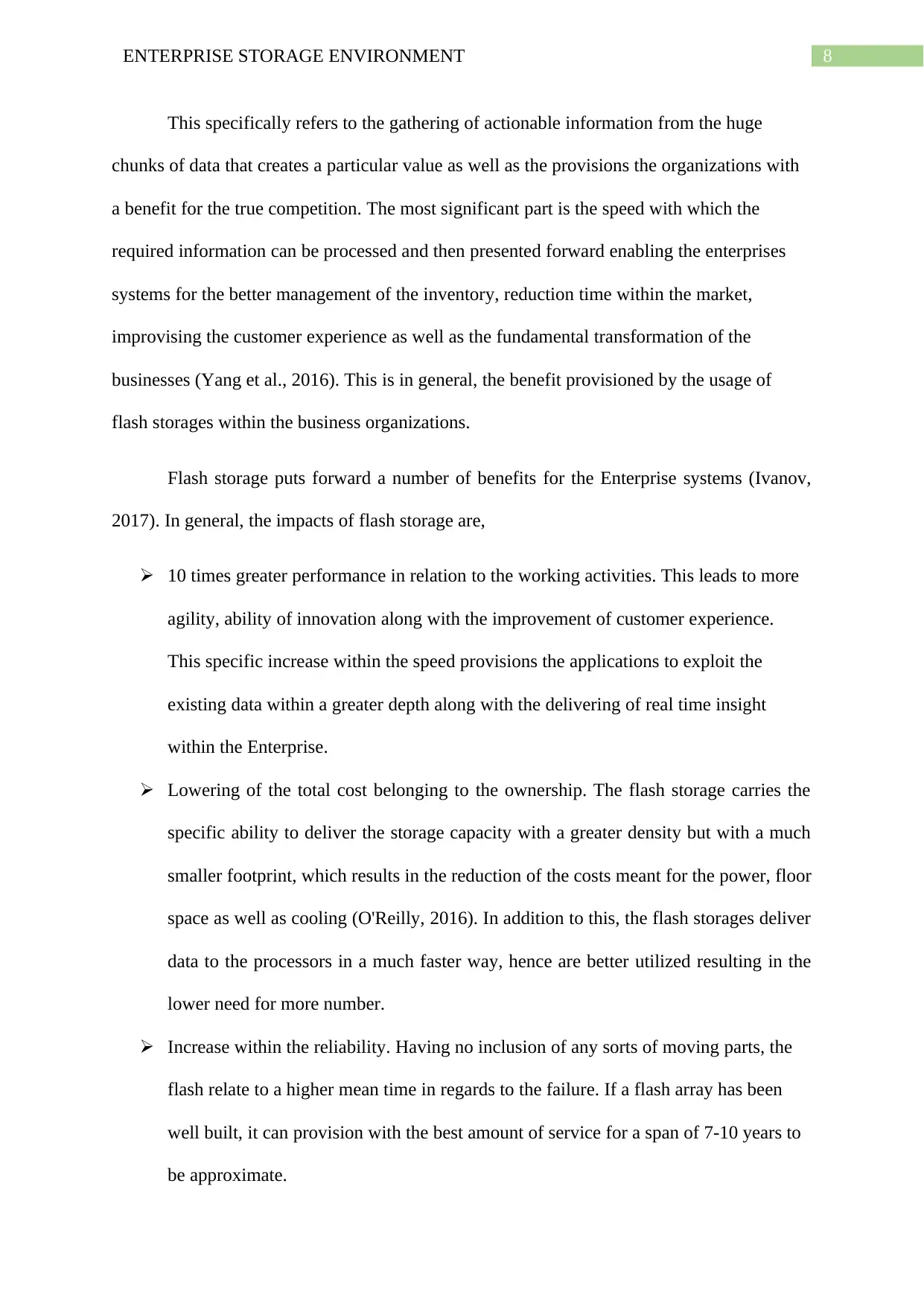
8ENTERPRISE STORAGE ENVIRONMENT
This specifically refers to the gathering of actionable information from the huge
chunks of data that creates a particular value as well as the provisions the organizations with
a benefit for the true competition. The most significant part is the speed with which the
required information can be processed and then presented forward enabling the enterprises
systems for the better management of the inventory, reduction time within the market,
improvising the customer experience as well as the fundamental transformation of the
businesses (Yang et al., 2016). This is in general, the benefit provisioned by the usage of
flash storages within the business organizations.
Flash storage puts forward a number of benefits for the Enterprise systems (Ivanov,
2017). In general, the impacts of flash storage are,
10 times greater performance in relation to the working activities. This leads to more
agility, ability of innovation along with the improvement of customer experience.
This specific increase within the speed provisions the applications to exploit the
existing data within a greater depth along with the delivering of real time insight
within the Enterprise.
Lowering of the total cost belonging to the ownership. The flash storage carries the
specific ability to deliver the storage capacity with a greater density but with a much
smaller footprint, which results in the reduction of the costs meant for the power, floor
space as well as cooling (O'Reilly, 2016). In addition to this, the flash storages deliver
data to the processors in a much faster way, hence are better utilized resulting in the
lower need for more number.
Increase within the reliability. Having no inclusion of any sorts of moving parts, the
flash relate to a higher mean time in regards to the failure. If a flash array has been
well built, it can provision with the best amount of service for a span of 7-10 years to
be approximate.
This specifically refers to the gathering of actionable information from the huge
chunks of data that creates a particular value as well as the provisions the organizations with
a benefit for the true competition. The most significant part is the speed with which the
required information can be processed and then presented forward enabling the enterprises
systems for the better management of the inventory, reduction time within the market,
improvising the customer experience as well as the fundamental transformation of the
businesses (Yang et al., 2016). This is in general, the benefit provisioned by the usage of
flash storages within the business organizations.
Flash storage puts forward a number of benefits for the Enterprise systems (Ivanov,
2017). In general, the impacts of flash storage are,
10 times greater performance in relation to the working activities. This leads to more
agility, ability of innovation along with the improvement of customer experience.
This specific increase within the speed provisions the applications to exploit the
existing data within a greater depth along with the delivering of real time insight
within the Enterprise.
Lowering of the total cost belonging to the ownership. The flash storage carries the
specific ability to deliver the storage capacity with a greater density but with a much
smaller footprint, which results in the reduction of the costs meant for the power, floor
space as well as cooling (O'Reilly, 2016). In addition to this, the flash storages deliver
data to the processors in a much faster way, hence are better utilized resulting in the
lower need for more number.
Increase within the reliability. Having no inclusion of any sorts of moving parts, the
flash relate to a higher mean time in regards to the failure. If a flash array has been
well built, it can provision with the best amount of service for a span of 7-10 years to
be approximate.
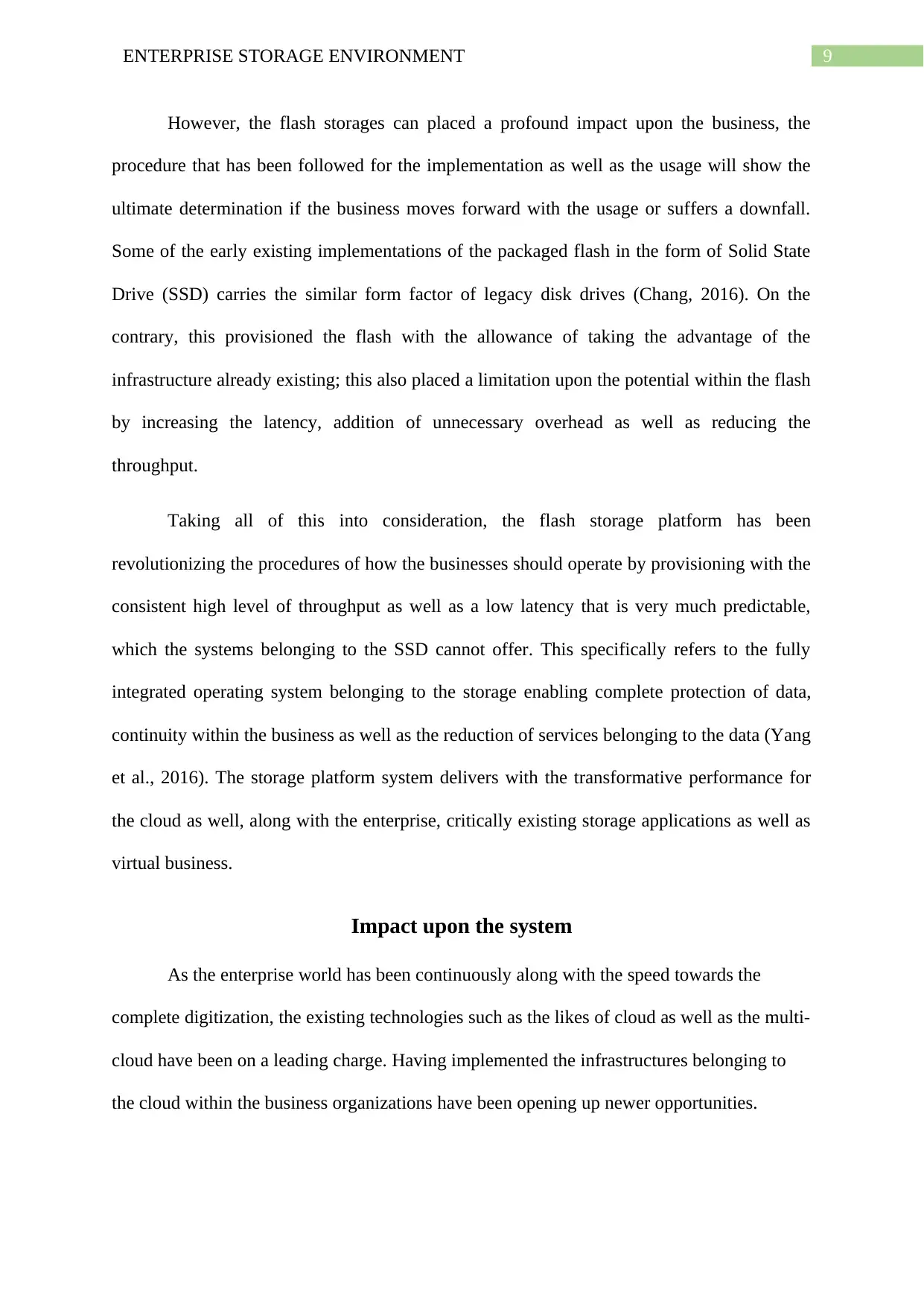
9ENTERPRISE STORAGE ENVIRONMENT
However, the flash storages can placed a profound impact upon the business, the
procedure that has been followed for the implementation as well as the usage will show the
ultimate determination if the business moves forward with the usage or suffers a downfall.
Some of the early existing implementations of the packaged flash in the form of Solid State
Drive (SSD) carries the similar form factor of legacy disk drives (Chang, 2016). On the
contrary, this provisioned the flash with the allowance of taking the advantage of the
infrastructure already existing; this also placed a limitation upon the potential within the flash
by increasing the latency, addition of unnecessary overhead as well as reducing the
throughput.
Taking all of this into consideration, the flash storage platform has been
revolutionizing the procedures of how the businesses should operate by provisioning with the
consistent high level of throughput as well as a low latency that is very much predictable,
which the systems belonging to the SSD cannot offer. This specifically refers to the fully
integrated operating system belonging to the storage enabling complete protection of data,
continuity within the business as well as the reduction of services belonging to the data (Yang
et al., 2016). The storage platform system delivers with the transformative performance for
the cloud as well, along with the enterprise, critically existing storage applications as well as
virtual business.
Impact upon the system
As the enterprise world has been continuously along with the speed towards the
complete digitization, the existing technologies such as the likes of cloud as well as the multi-
cloud have been on a leading charge. Having implemented the infrastructures belonging to
the cloud within the business organizations have been opening up newer opportunities.
However, the flash storages can placed a profound impact upon the business, the
procedure that has been followed for the implementation as well as the usage will show the
ultimate determination if the business moves forward with the usage or suffers a downfall.
Some of the early existing implementations of the packaged flash in the form of Solid State
Drive (SSD) carries the similar form factor of legacy disk drives (Chang, 2016). On the
contrary, this provisioned the flash with the allowance of taking the advantage of the
infrastructure already existing; this also placed a limitation upon the potential within the flash
by increasing the latency, addition of unnecessary overhead as well as reducing the
throughput.
Taking all of this into consideration, the flash storage platform has been
revolutionizing the procedures of how the businesses should operate by provisioning with the
consistent high level of throughput as well as a low latency that is very much predictable,
which the systems belonging to the SSD cannot offer. This specifically refers to the fully
integrated operating system belonging to the storage enabling complete protection of data,
continuity within the business as well as the reduction of services belonging to the data (Yang
et al., 2016). The storage platform system delivers with the transformative performance for
the cloud as well, along with the enterprise, critically existing storage applications as well as
virtual business.
Impact upon the system
As the enterprise world has been continuously along with the speed towards the
complete digitization, the existing technologies such as the likes of cloud as well as the multi-
cloud have been on a leading charge. Having implemented the infrastructures belonging to
the cloud within the business organizations have been opening up newer opportunities.
Secure Best Marks with AI Grader
Need help grading? Try our AI Grader for instant feedback on your assignments.
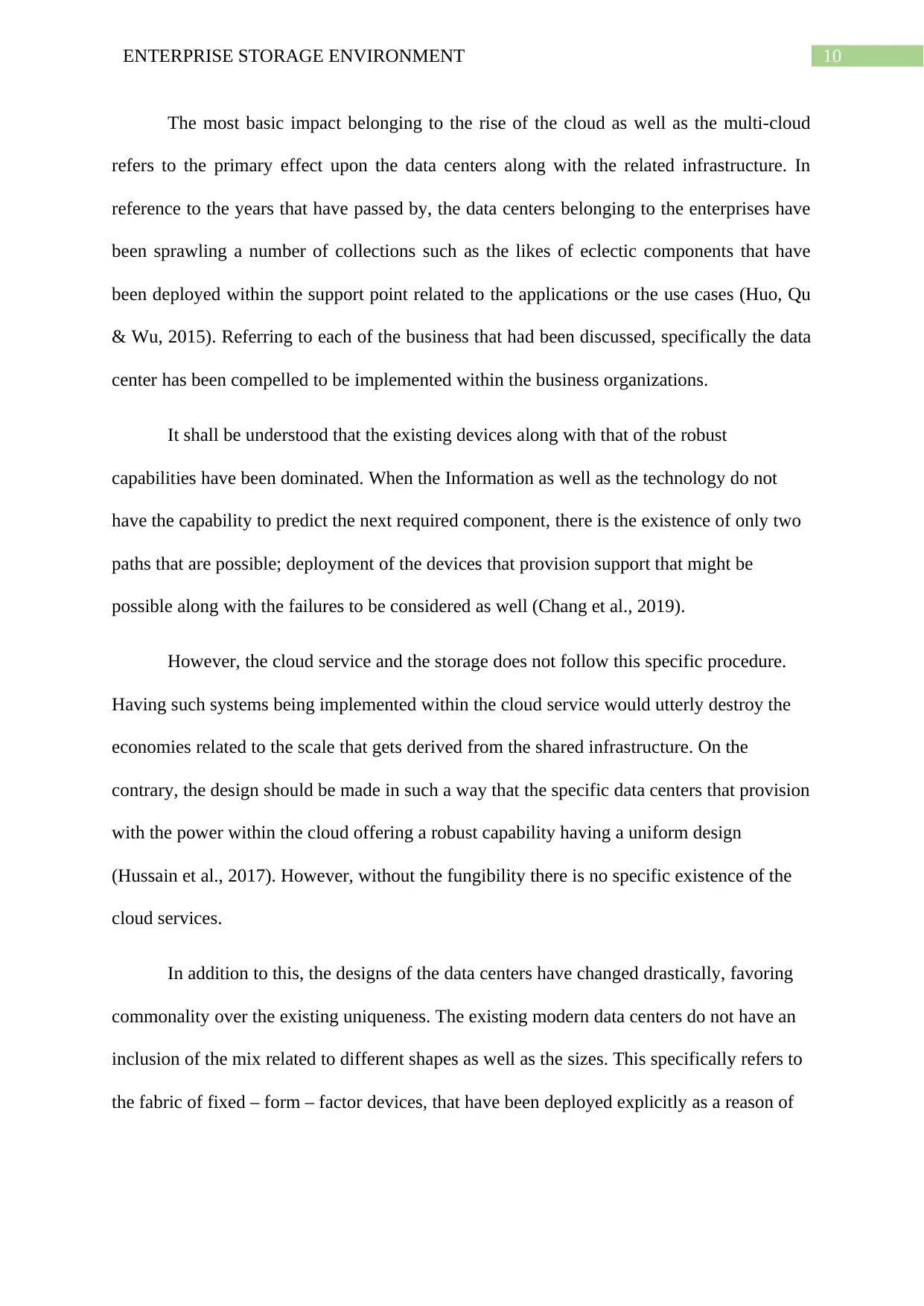
10ENTERPRISE STORAGE ENVIRONMENT
The most basic impact belonging to the rise of the cloud as well as the multi-cloud
refers to the primary effect upon the data centers along with the related infrastructure. In
reference to the years that have passed by, the data centers belonging to the enterprises have
been sprawling a number of collections such as the likes of eclectic components that have
been deployed within the support point related to the applications or the use cases (Huo, Qu
& Wu, 2015). Referring to each of the business that had been discussed, specifically the data
center has been compelled to be implemented within the business organizations.
It shall be understood that the existing devices along with that of the robust
capabilities have been dominated. When the Information as well as the technology do not
have the capability to predict the next required component, there is the existence of only two
paths that are possible; deployment of the devices that provision support that might be
possible along with the failures to be considered as well (Chang et al., 2019).
However, the cloud service and the storage does not follow this specific procedure.
Having such systems being implemented within the cloud service would utterly destroy the
economies related to the scale that gets derived from the shared infrastructure. On the
contrary, the design should be made in such a way that the specific data centers that provision
with the power within the cloud offering a robust capability having a uniform design
(Hussain et al., 2017). However, without the fungibility there is no specific existence of the
cloud services.
In addition to this, the designs of the data centers have changed drastically, favoring
commonality over the existing uniqueness. The existing modern data centers do not have an
inclusion of the mix related to different shapes as well as the sizes. This specifically refers to
the fabric of fixed – form – factor devices, that have been deployed explicitly as a reason of
The most basic impact belonging to the rise of the cloud as well as the multi-cloud
refers to the primary effect upon the data centers along with the related infrastructure. In
reference to the years that have passed by, the data centers belonging to the enterprises have
been sprawling a number of collections such as the likes of eclectic components that have
been deployed within the support point related to the applications or the use cases (Huo, Qu
& Wu, 2015). Referring to each of the business that had been discussed, specifically the data
center has been compelled to be implemented within the business organizations.
It shall be understood that the existing devices along with that of the robust
capabilities have been dominated. When the Information as well as the technology do not
have the capability to predict the next required component, there is the existence of only two
paths that are possible; deployment of the devices that provision support that might be
possible along with the failures to be considered as well (Chang et al., 2019).
However, the cloud service and the storage does not follow this specific procedure.
Having such systems being implemented within the cloud service would utterly destroy the
economies related to the scale that gets derived from the shared infrastructure. On the
contrary, the design should be made in such a way that the specific data centers that provision
with the power within the cloud offering a robust capability having a uniform design
(Hussain et al., 2017). However, without the fungibility there is no specific existence of the
cloud services.
In addition to this, the designs of the data centers have changed drastically, favoring
commonality over the existing uniqueness. The existing modern data centers do not have an
inclusion of the mix related to different shapes as well as the sizes. This specifically refers to
the fabric of fixed – form – factor devices, that have been deployed explicitly as a reason of
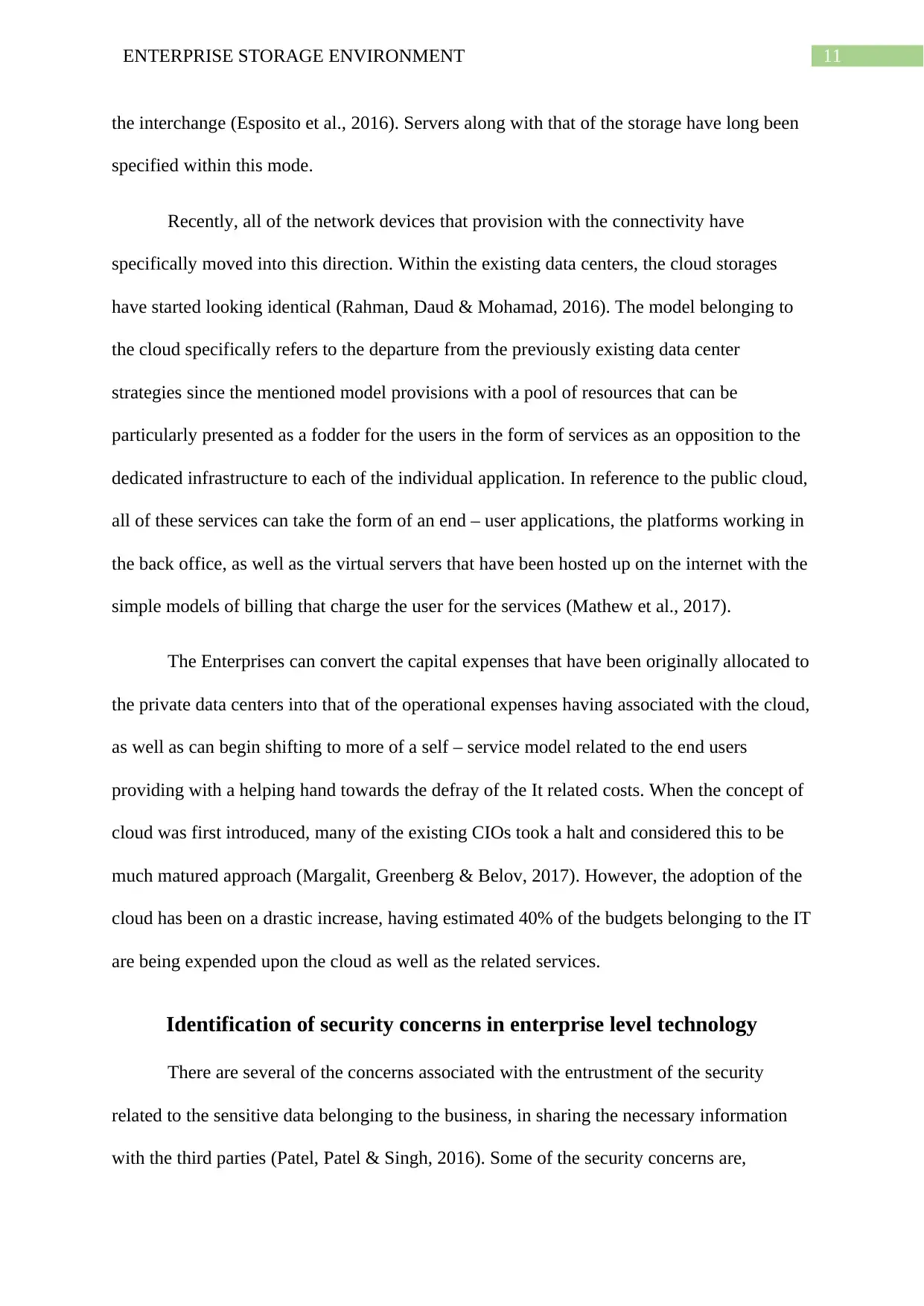
11ENTERPRISE STORAGE ENVIRONMENT
the interchange (Esposito et al., 2016). Servers along with that of the storage have long been
specified within this mode.
Recently, all of the network devices that provision with the connectivity have
specifically moved into this direction. Within the existing data centers, the cloud storages
have started looking identical (Rahman, Daud & Mohamad, 2016). The model belonging to
the cloud specifically refers to the departure from the previously existing data center
strategies since the mentioned model provisions with a pool of resources that can be
particularly presented as a fodder for the users in the form of services as an opposition to the
dedicated infrastructure to each of the individual application. In reference to the public cloud,
all of these services can take the form of an end – user applications, the platforms working in
the back office, as well as the virtual servers that have been hosted up on the internet with the
simple models of billing that charge the user for the services (Mathew et al., 2017).
The Enterprises can convert the capital expenses that have been originally allocated to
the private data centers into that of the operational expenses having associated with the cloud,
as well as can begin shifting to more of a self – service model related to the end users
providing with a helping hand towards the defray of the It related costs. When the concept of
cloud was first introduced, many of the existing CIOs took a halt and considered this to be
much matured approach (Margalit, Greenberg & Belov, 2017). However, the adoption of the
cloud has been on a drastic increase, having estimated 40% of the budgets belonging to the IT
are being expended upon the cloud as well as the related services.
Identification of security concerns in enterprise level technology
There are several of the concerns associated with the entrustment of the security
related to the sensitive data belonging to the business, in sharing the necessary information
with the third parties (Patel, Patel & Singh, 2016). Some of the security concerns are,
the interchange (Esposito et al., 2016). Servers along with that of the storage have long been
specified within this mode.
Recently, all of the network devices that provision with the connectivity have
specifically moved into this direction. Within the existing data centers, the cloud storages
have started looking identical (Rahman, Daud & Mohamad, 2016). The model belonging to
the cloud specifically refers to the departure from the previously existing data center
strategies since the mentioned model provisions with a pool of resources that can be
particularly presented as a fodder for the users in the form of services as an opposition to the
dedicated infrastructure to each of the individual application. In reference to the public cloud,
all of these services can take the form of an end – user applications, the platforms working in
the back office, as well as the virtual servers that have been hosted up on the internet with the
simple models of billing that charge the user for the services (Mathew et al., 2017).
The Enterprises can convert the capital expenses that have been originally allocated to
the private data centers into that of the operational expenses having associated with the cloud,
as well as can begin shifting to more of a self – service model related to the end users
providing with a helping hand towards the defray of the It related costs. When the concept of
cloud was first introduced, many of the existing CIOs took a halt and considered this to be
much matured approach (Margalit, Greenberg & Belov, 2017). However, the adoption of the
cloud has been on a drastic increase, having estimated 40% of the budgets belonging to the IT
are being expended upon the cloud as well as the related services.
Identification of security concerns in enterprise level technology
There are several of the concerns associated with the entrustment of the security
related to the sensitive data belonging to the business, in sharing the necessary information
with the third parties (Patel, Patel & Singh, 2016). Some of the security concerns are,
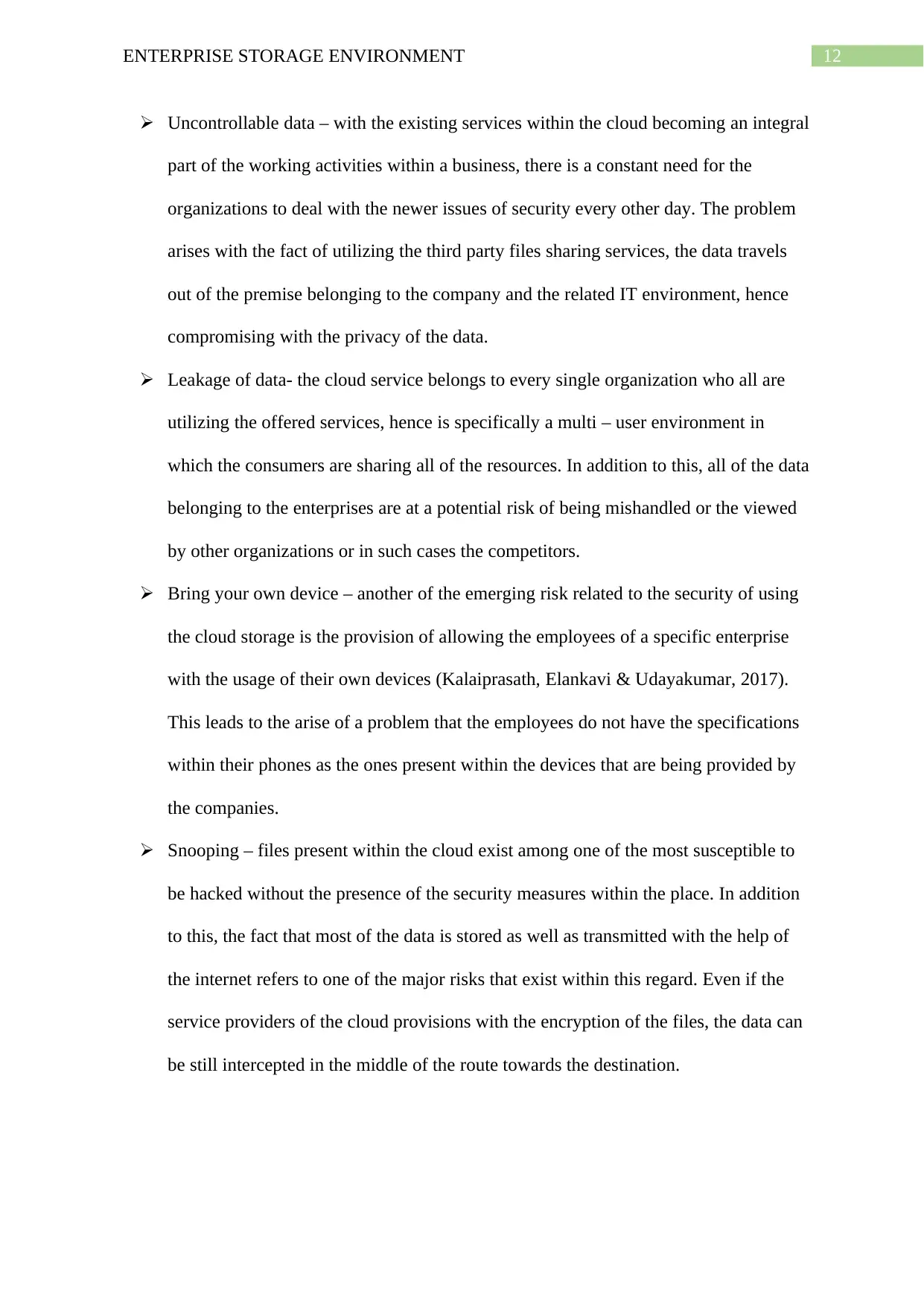
12ENTERPRISE STORAGE ENVIRONMENT
Uncontrollable data – with the existing services within the cloud becoming an integral
part of the working activities within a business, there is a constant need for the
organizations to deal with the newer issues of security every other day. The problem
arises with the fact of utilizing the third party files sharing services, the data travels
out of the premise belonging to the company and the related IT environment, hence
compromising with the privacy of the data.
Leakage of data- the cloud service belongs to every single organization who all are
utilizing the offered services, hence is specifically a multi – user environment in
which the consumers are sharing all of the resources. In addition to this, all of the data
belonging to the enterprises are at a potential risk of being mishandled or the viewed
by other organizations or in such cases the competitors.
Bring your own device – another of the emerging risk related to the security of using
the cloud storage is the provision of allowing the employees of a specific enterprise
with the usage of their own devices (Kalaiprasath, Elankavi & Udayakumar, 2017).
This leads to the arise of a problem that the employees do not have the specifications
within their phones as the ones present within the devices that are being provided by
the companies.
Snooping – files present within the cloud exist among one of the most susceptible to
be hacked without the presence of the security measures within the place. In addition
to this, the fact that most of the data is stored as well as transmitted with the help of
the internet refers to one of the major risks that exist within this regard. Even if the
service providers of the cloud provisions with the encryption of the files, the data can
be still intercepted in the middle of the route towards the destination.
Uncontrollable data – with the existing services within the cloud becoming an integral
part of the working activities within a business, there is a constant need for the
organizations to deal with the newer issues of security every other day. The problem
arises with the fact of utilizing the third party files sharing services, the data travels
out of the premise belonging to the company and the related IT environment, hence
compromising with the privacy of the data.
Leakage of data- the cloud service belongs to every single organization who all are
utilizing the offered services, hence is specifically a multi – user environment in
which the consumers are sharing all of the resources. In addition to this, all of the data
belonging to the enterprises are at a potential risk of being mishandled or the viewed
by other organizations or in such cases the competitors.
Bring your own device – another of the emerging risk related to the security of using
the cloud storage is the provision of allowing the employees of a specific enterprise
with the usage of their own devices (Kalaiprasath, Elankavi & Udayakumar, 2017).
This leads to the arise of a problem that the employees do not have the specifications
within their phones as the ones present within the devices that are being provided by
the companies.
Snooping – files present within the cloud exist among one of the most susceptible to
be hacked without the presence of the security measures within the place. In addition
to this, the fact that most of the data is stored as well as transmitted with the help of
the internet refers to one of the major risks that exist within this regard. Even if the
service providers of the cloud provisions with the encryption of the files, the data can
be still intercepted in the middle of the route towards the destination.
Paraphrase This Document
Need a fresh take? Get an instant paraphrase of this document with our AI Paraphraser
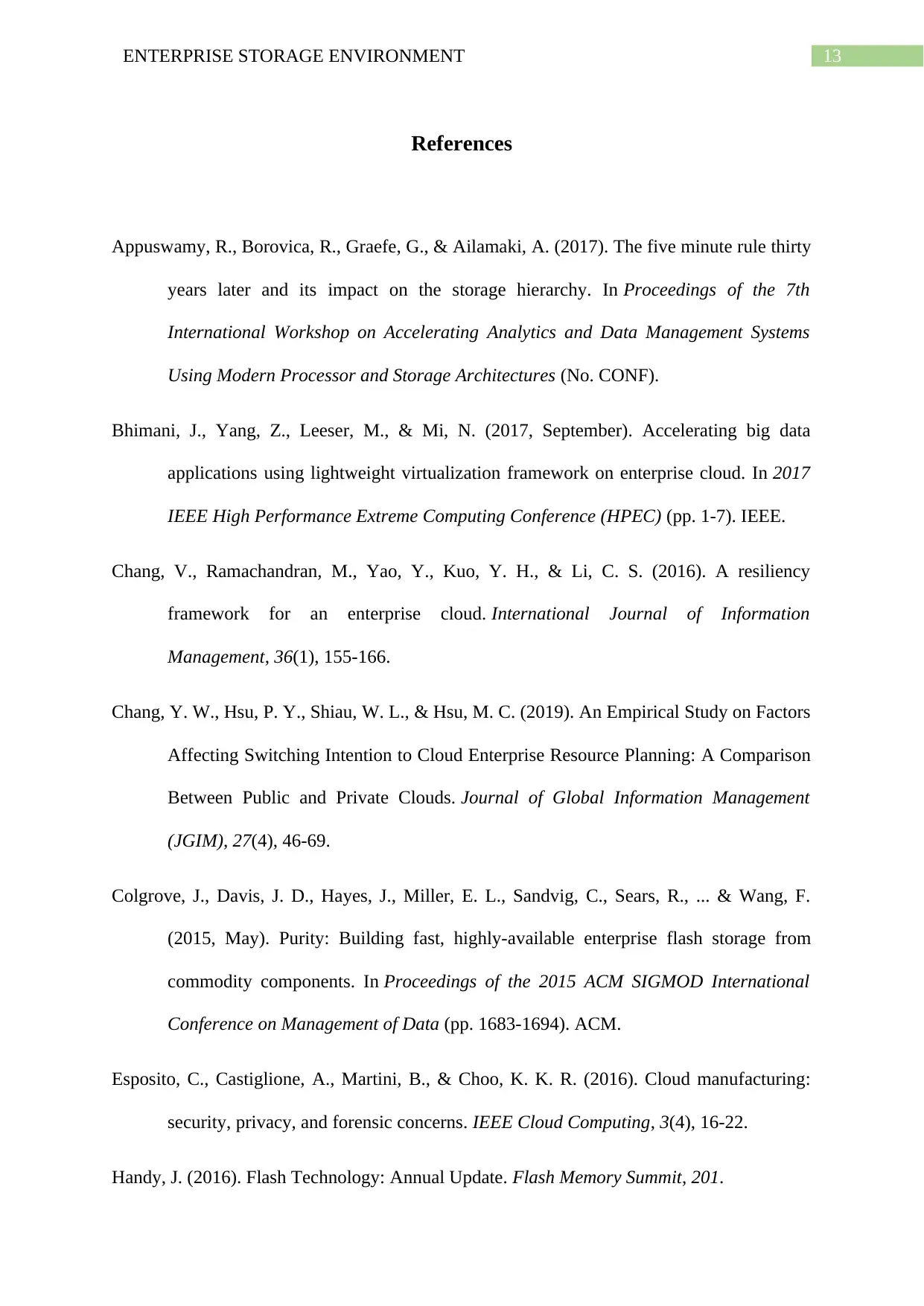
13ENTERPRISE STORAGE ENVIRONMENT
References
Appuswamy, R., Borovica, R., Graefe, G., & Ailamaki, A. (2017). The five minute rule thirty
years later and its impact on the storage hierarchy. In Proceedings of the 7th
International Workshop on Accelerating Analytics and Data Management Systems
Using Modern Processor and Storage Architectures (No. CONF).
Bhimani, J., Yang, Z., Leeser, M., & Mi, N. (2017, September). Accelerating big data
applications using lightweight virtualization framework on enterprise cloud. In 2017
IEEE High Performance Extreme Computing Conference (HPEC) (pp. 1-7). IEEE.
Chang, V., Ramachandran, M., Yao, Y., Kuo, Y. H., & Li, C. S. (2016). A resiliency
framework for an enterprise cloud. International Journal of Information
Management, 36(1), 155-166.
Chang, Y. W., Hsu, P. Y., Shiau, W. L., & Hsu, M. C. (2019). An Empirical Study on Factors
Affecting Switching Intention to Cloud Enterprise Resource Planning: A Comparison
Between Public and Private Clouds. Journal of Global Information Management
(JGIM), 27(4), 46-69.
Colgrove, J., Davis, J. D., Hayes, J., Miller, E. L., Sandvig, C., Sears, R., ... & Wang, F.
(2015, May). Purity: Building fast, highly-available enterprise flash storage from
commodity components. In Proceedings of the 2015 ACM SIGMOD International
Conference on Management of Data (pp. 1683-1694). ACM.
Esposito, C., Castiglione, A., Martini, B., & Choo, K. K. R. (2016). Cloud manufacturing:
security, privacy, and forensic concerns. IEEE Cloud Computing, 3(4), 16-22.
Handy, J. (2016). Flash Technology: Annual Update. Flash Memory Summit, 201.
References
Appuswamy, R., Borovica, R., Graefe, G., & Ailamaki, A. (2017). The five minute rule thirty
years later and its impact on the storage hierarchy. In Proceedings of the 7th
International Workshop on Accelerating Analytics and Data Management Systems
Using Modern Processor and Storage Architectures (No. CONF).
Bhimani, J., Yang, Z., Leeser, M., & Mi, N. (2017, September). Accelerating big data
applications using lightweight virtualization framework on enterprise cloud. In 2017
IEEE High Performance Extreme Computing Conference (HPEC) (pp. 1-7). IEEE.
Chang, V., Ramachandran, M., Yao, Y., Kuo, Y. H., & Li, C. S. (2016). A resiliency
framework for an enterprise cloud. International Journal of Information
Management, 36(1), 155-166.
Chang, Y. W., Hsu, P. Y., Shiau, W. L., & Hsu, M. C. (2019). An Empirical Study on Factors
Affecting Switching Intention to Cloud Enterprise Resource Planning: A Comparison
Between Public and Private Clouds. Journal of Global Information Management
(JGIM), 27(4), 46-69.
Colgrove, J., Davis, J. D., Hayes, J., Miller, E. L., Sandvig, C., Sears, R., ... & Wang, F.
(2015, May). Purity: Building fast, highly-available enterprise flash storage from
commodity components. In Proceedings of the 2015 ACM SIGMOD International
Conference on Management of Data (pp. 1683-1694). ACM.
Esposito, C., Castiglione, A., Martini, B., & Choo, K. K. R. (2016). Cloud manufacturing:
security, privacy, and forensic concerns. IEEE Cloud Computing, 3(4), 16-22.
Handy, J. (2016). Flash Technology: Annual Update. Flash Memory Summit, 201.
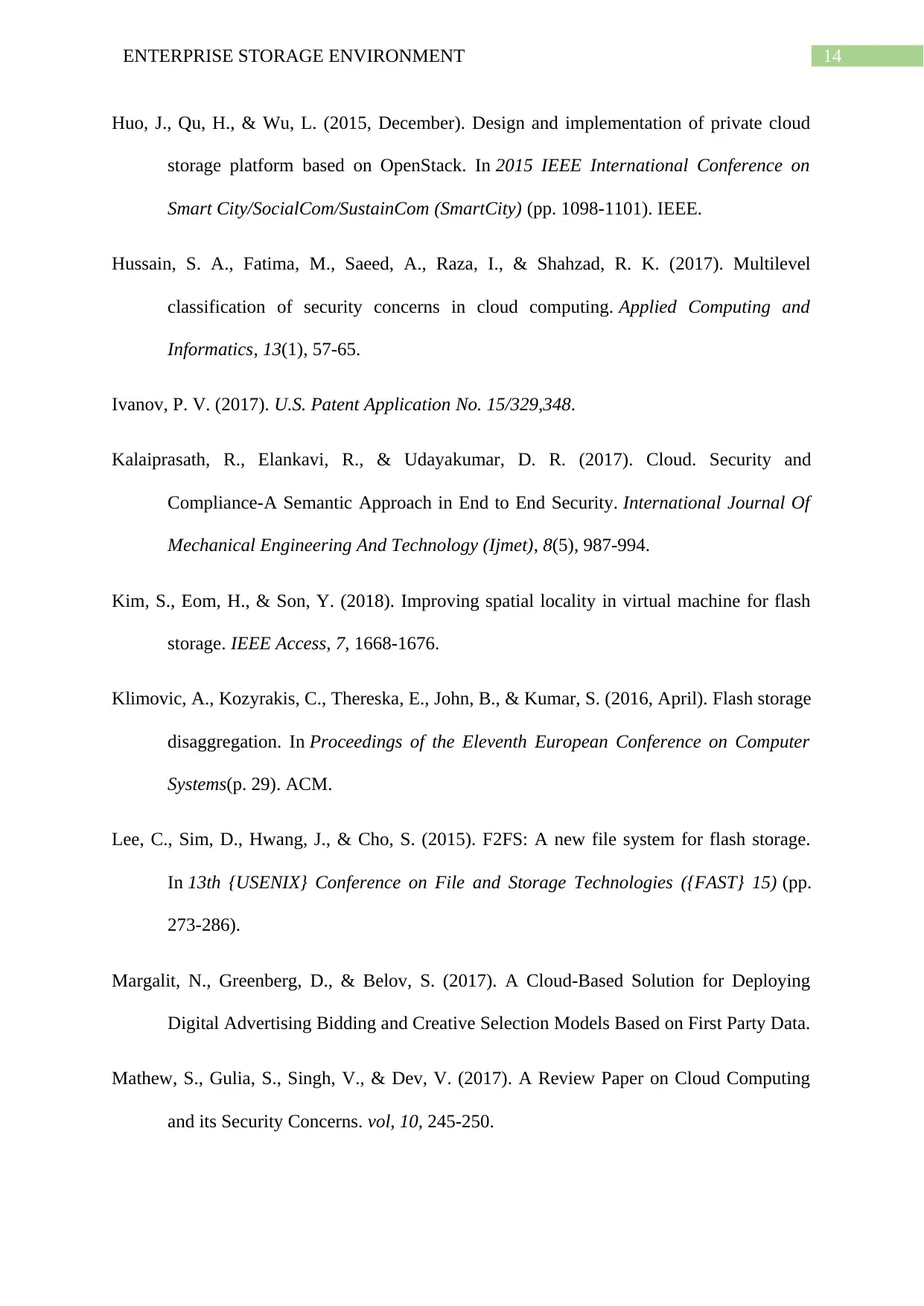
14ENTERPRISE STORAGE ENVIRONMENT
Huo, J., Qu, H., & Wu, L. (2015, December). Design and implementation of private cloud
storage platform based on OpenStack. In 2015 IEEE International Conference on
Smart City/SocialCom/SustainCom (SmartCity) (pp. 1098-1101). IEEE.
Hussain, S. A., Fatima, M., Saeed, A., Raza, I., & Shahzad, R. K. (2017). Multilevel
classification of security concerns in cloud computing. Applied Computing and
Informatics, 13(1), 57-65.
Ivanov, P. V. (2017). U.S. Patent Application No. 15/329,348.
Kalaiprasath, R., Elankavi, R., & Udayakumar, D. R. (2017). Cloud. Security and
Compliance-A Semantic Approach in End to End Security. International Journal Of
Mechanical Engineering And Technology (Ijmet), 8(5), 987-994.
Kim, S., Eom, H., & Son, Y. (2018). Improving spatial locality in virtual machine for flash
storage. IEEE Access, 7, 1668-1676.
Klimovic, A., Kozyrakis, C., Thereska, E., John, B., & Kumar, S. (2016, April). Flash storage
disaggregation. In Proceedings of the Eleventh European Conference on Computer
Systems(p. 29). ACM.
Lee, C., Sim, D., Hwang, J., & Cho, S. (2015). F2FS: A new file system for flash storage.
In 13th {USENIX} Conference on File and Storage Technologies ({FAST} 15) (pp.
273-286).
Margalit, N., Greenberg, D., & Belov, S. (2017). A Cloud-Based Solution for Deploying
Digital Advertising Bidding and Creative Selection Models Based on First Party Data.
Mathew, S., Gulia, S., Singh, V., & Dev, V. (2017). A Review Paper on Cloud Computing
and its Security Concerns. vol, 10, 245-250.
Huo, J., Qu, H., & Wu, L. (2015, December). Design and implementation of private cloud
storage platform based on OpenStack. In 2015 IEEE International Conference on
Smart City/SocialCom/SustainCom (SmartCity) (pp. 1098-1101). IEEE.
Hussain, S. A., Fatima, M., Saeed, A., Raza, I., & Shahzad, R. K. (2017). Multilevel
classification of security concerns in cloud computing. Applied Computing and
Informatics, 13(1), 57-65.
Ivanov, P. V. (2017). U.S. Patent Application No. 15/329,348.
Kalaiprasath, R., Elankavi, R., & Udayakumar, D. R. (2017). Cloud. Security and
Compliance-A Semantic Approach in End to End Security. International Journal Of
Mechanical Engineering And Technology (Ijmet), 8(5), 987-994.
Kim, S., Eom, H., & Son, Y. (2018). Improving spatial locality in virtual machine for flash
storage. IEEE Access, 7, 1668-1676.
Klimovic, A., Kozyrakis, C., Thereska, E., John, B., & Kumar, S. (2016, April). Flash storage
disaggregation. In Proceedings of the Eleventh European Conference on Computer
Systems(p. 29). ACM.
Lee, C., Sim, D., Hwang, J., & Cho, S. (2015). F2FS: A new file system for flash storage.
In 13th {USENIX} Conference on File and Storage Technologies ({FAST} 15) (pp.
273-286).
Margalit, N., Greenberg, D., & Belov, S. (2017). A Cloud-Based Solution for Deploying
Digital Advertising Bidding and Creative Selection Models Based on First Party Data.
Mathew, S., Gulia, S., Singh, V., & Dev, V. (2017). A Review Paper on Cloud Computing
and its Security Concerns. vol, 10, 245-250.
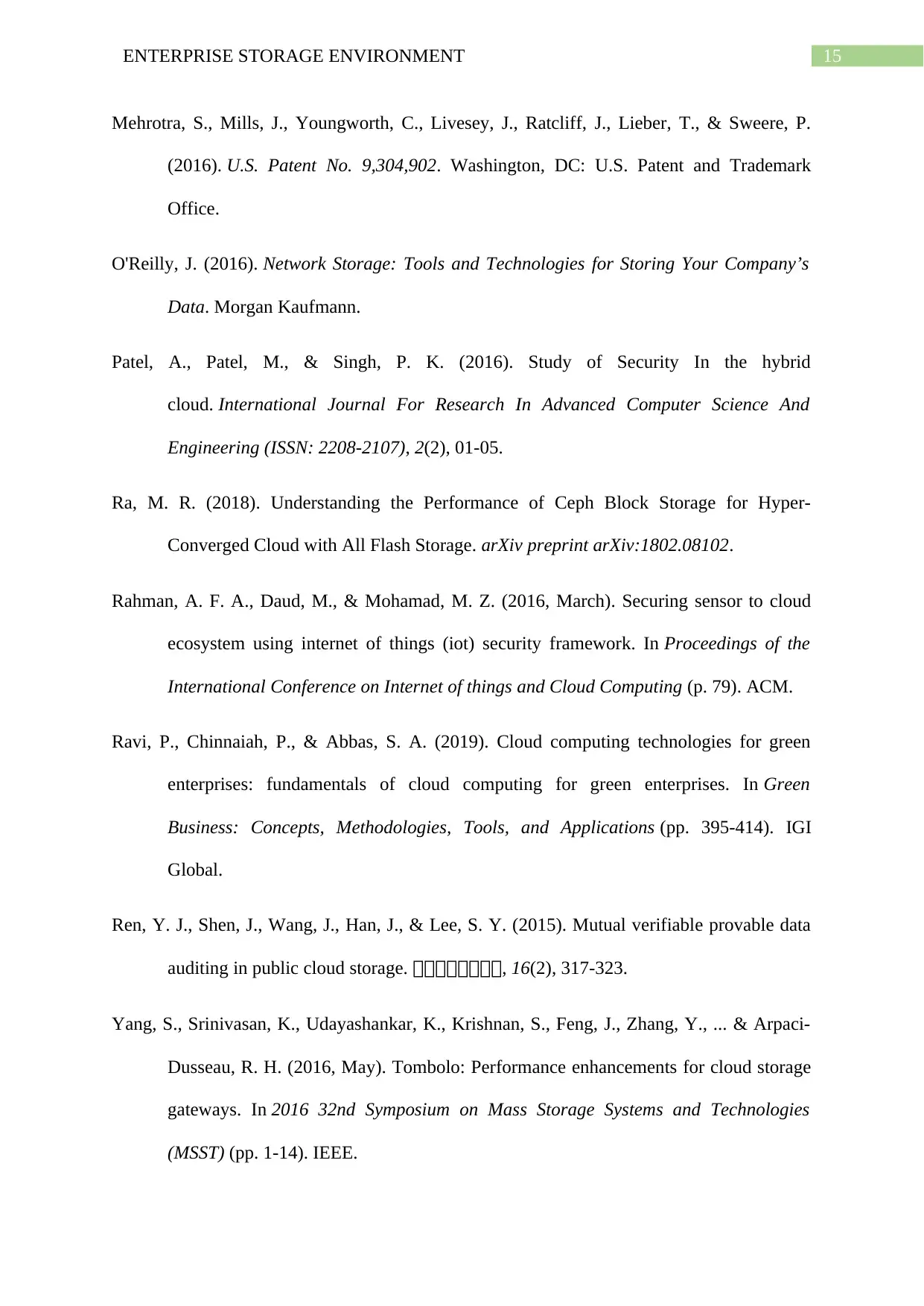
15ENTERPRISE STORAGE ENVIRONMENT
Mehrotra, S., Mills, J., Youngworth, C., Livesey, J., Ratcliff, J., Lieber, T., & Sweere, P.
(2016). U.S. Patent No. 9,304,902. Washington, DC: U.S. Patent and Trademark
Office.
O'Reilly, J. (2016). Network Storage: Tools and Technologies for Storing Your Company’s
Data. Morgan Kaufmann.
Patel, A., Patel, M., & Singh, P. K. (2016). Study of Security In the hybrid
cloud. International Journal For Research In Advanced Computer Science And
Engineering (ISSN: 2208-2107), 2(2), 01-05.
Ra, M. R. (2018). Understanding the Performance of Ceph Block Storage for Hyper-
Converged Cloud with All Flash Storage. arXiv preprint arXiv:1802.08102.
Rahman, A. F. A., Daud, M., & Mohamad, M. Z. (2016, March). Securing sensor to cloud
ecosystem using internet of things (iot) security framework. In Proceedings of the
International Conference on Internet of things and Cloud Computing (p. 79). ACM.
Ravi, P., Chinnaiah, P., & Abbas, S. A. (2019). Cloud computing technologies for green
enterprises: fundamentals of cloud computing for green enterprises. In Green
Business: Concepts, Methodologies, Tools, and Applications (pp. 395-414). IGI
Global.
Ren, Y. J., Shen, J., Wang, J., Han, J., & Lee, S. Y. (2015). Mutual verifiable provable data
auditing in public cloud storage. 網網網網網網網網, 16(2), 317-323.
Yang, S., Srinivasan, K., Udayashankar, K., Krishnan, S., Feng, J., Zhang, Y., ... & Arpaci-
Dusseau, R. H. (2016, May). Tombolo: Performance enhancements for cloud storage
gateways. In 2016 32nd Symposium on Mass Storage Systems and Technologies
(MSST) (pp. 1-14). IEEE.
Mehrotra, S., Mills, J., Youngworth, C., Livesey, J., Ratcliff, J., Lieber, T., & Sweere, P.
(2016). U.S. Patent No. 9,304,902. Washington, DC: U.S. Patent and Trademark
Office.
O'Reilly, J. (2016). Network Storage: Tools and Technologies for Storing Your Company’s
Data. Morgan Kaufmann.
Patel, A., Patel, M., & Singh, P. K. (2016). Study of Security In the hybrid
cloud. International Journal For Research In Advanced Computer Science And
Engineering (ISSN: 2208-2107), 2(2), 01-05.
Ra, M. R. (2018). Understanding the Performance of Ceph Block Storage for Hyper-
Converged Cloud with All Flash Storage. arXiv preprint arXiv:1802.08102.
Rahman, A. F. A., Daud, M., & Mohamad, M. Z. (2016, March). Securing sensor to cloud
ecosystem using internet of things (iot) security framework. In Proceedings of the
International Conference on Internet of things and Cloud Computing (p. 79). ACM.
Ravi, P., Chinnaiah, P., & Abbas, S. A. (2019). Cloud computing technologies for green
enterprises: fundamentals of cloud computing for green enterprises. In Green
Business: Concepts, Methodologies, Tools, and Applications (pp. 395-414). IGI
Global.
Ren, Y. J., Shen, J., Wang, J., Han, J., & Lee, S. Y. (2015). Mutual verifiable provable data
auditing in public cloud storage. 網網網網網網網網, 16(2), 317-323.
Yang, S., Srinivasan, K., Udayashankar, K., Krishnan, S., Feng, J., Zhang, Y., ... & Arpaci-
Dusseau, R. H. (2016, May). Tombolo: Performance enhancements for cloud storage
gateways. In 2016 32nd Symposium on Mass Storage Systems and Technologies
(MSST) (pp. 1-14). IEEE.
Secure Best Marks with AI Grader
Need help grading? Try our AI Grader for instant feedback on your assignments.
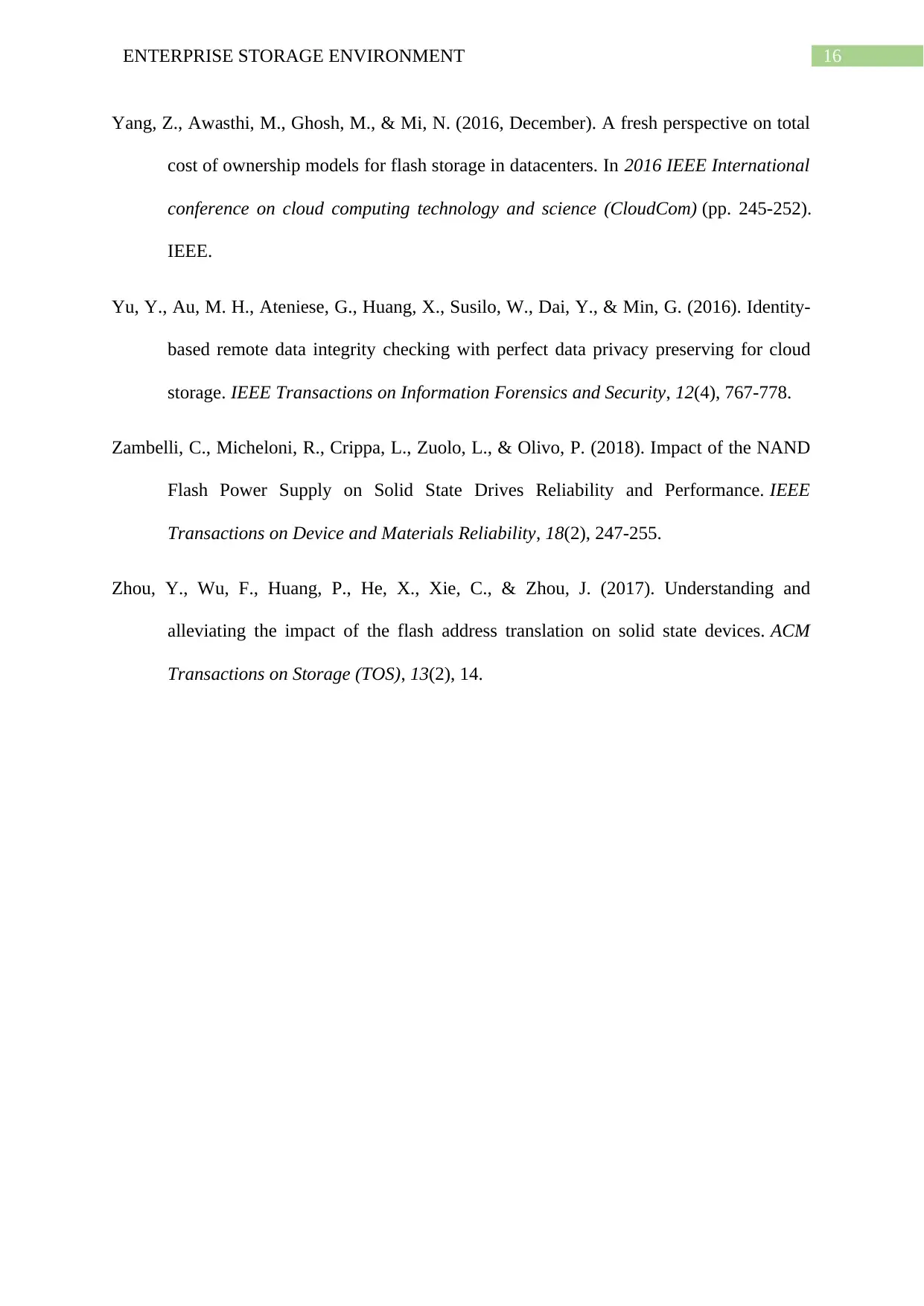
16ENTERPRISE STORAGE ENVIRONMENT
Yang, Z., Awasthi, M., Ghosh, M., & Mi, N. (2016, December). A fresh perspective on total
cost of ownership models for flash storage in datacenters. In 2016 IEEE International
conference on cloud computing technology and science (CloudCom) (pp. 245-252).
IEEE.
Yu, Y., Au, M. H., Ateniese, G., Huang, X., Susilo, W., Dai, Y., & Min, G. (2016). Identity-
based remote data integrity checking with perfect data privacy preserving for cloud
storage. IEEE Transactions on Information Forensics and Security, 12(4), 767-778.
Zambelli, C., Micheloni, R., Crippa, L., Zuolo, L., & Olivo, P. (2018). Impact of the NAND
Flash Power Supply on Solid State Drives Reliability and Performance. IEEE
Transactions on Device and Materials Reliability, 18(2), 247-255.
Zhou, Y., Wu, F., Huang, P., He, X., Xie, C., & Zhou, J. (2017). Understanding and
alleviating the impact of the flash address translation on solid state devices. ACM
Transactions on Storage (TOS), 13(2), 14.
Yang, Z., Awasthi, M., Ghosh, M., & Mi, N. (2016, December). A fresh perspective on total
cost of ownership models for flash storage in datacenters. In 2016 IEEE International
conference on cloud computing technology and science (CloudCom) (pp. 245-252).
IEEE.
Yu, Y., Au, M. H., Ateniese, G., Huang, X., Susilo, W., Dai, Y., & Min, G. (2016). Identity-
based remote data integrity checking with perfect data privacy preserving for cloud
storage. IEEE Transactions on Information Forensics and Security, 12(4), 767-778.
Zambelli, C., Micheloni, R., Crippa, L., Zuolo, L., & Olivo, P. (2018). Impact of the NAND
Flash Power Supply on Solid State Drives Reliability and Performance. IEEE
Transactions on Device and Materials Reliability, 18(2), 247-255.
Zhou, Y., Wu, F., Huang, P., He, X., Xie, C., & Zhou, J. (2017). Understanding and
alleviating the impact of the flash address translation on solid state devices. ACM
Transactions on Storage (TOS), 13(2), 14.
1 out of 17
Your All-in-One AI-Powered Toolkit for Academic Success.
+13062052269
info@desklib.com
Available 24*7 on WhatsApp / Email
![[object Object]](/_next/static/media/star-bottom.7253800d.svg)
Unlock your academic potential
© 2024 | Zucol Services PVT LTD | All rights reserved.





